

BOLT TX60C HIGH-RESOLUTION THERMAL SCOPE
PAGE 4
SELLING THE NIGHT
CYBERATTACKS
OPTICS 2024 RIFLESCOPES AND RED-DOTS DOMINATE TODAY’S MARKET PAGE 18 NEW PRODUCTS
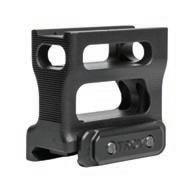









BOLT TX60C HIGH-RESOLUTION THERMAL SCOPE
PAGE 4
SELLING THE NIGHT
CYBERATTACKS
OPTICS 2024 RIFLESCOPES AND RED-DOTS DOMINATE TODAY’S MARKET PAGE 18 NEW PRODUCTS







Red Cat’s family of ISR and precision strike solutions support multi-domain operations, for U.S. and Allied Defense and Security forces, with an advanced suite of artificial intelligence and computer-vision capabilities.
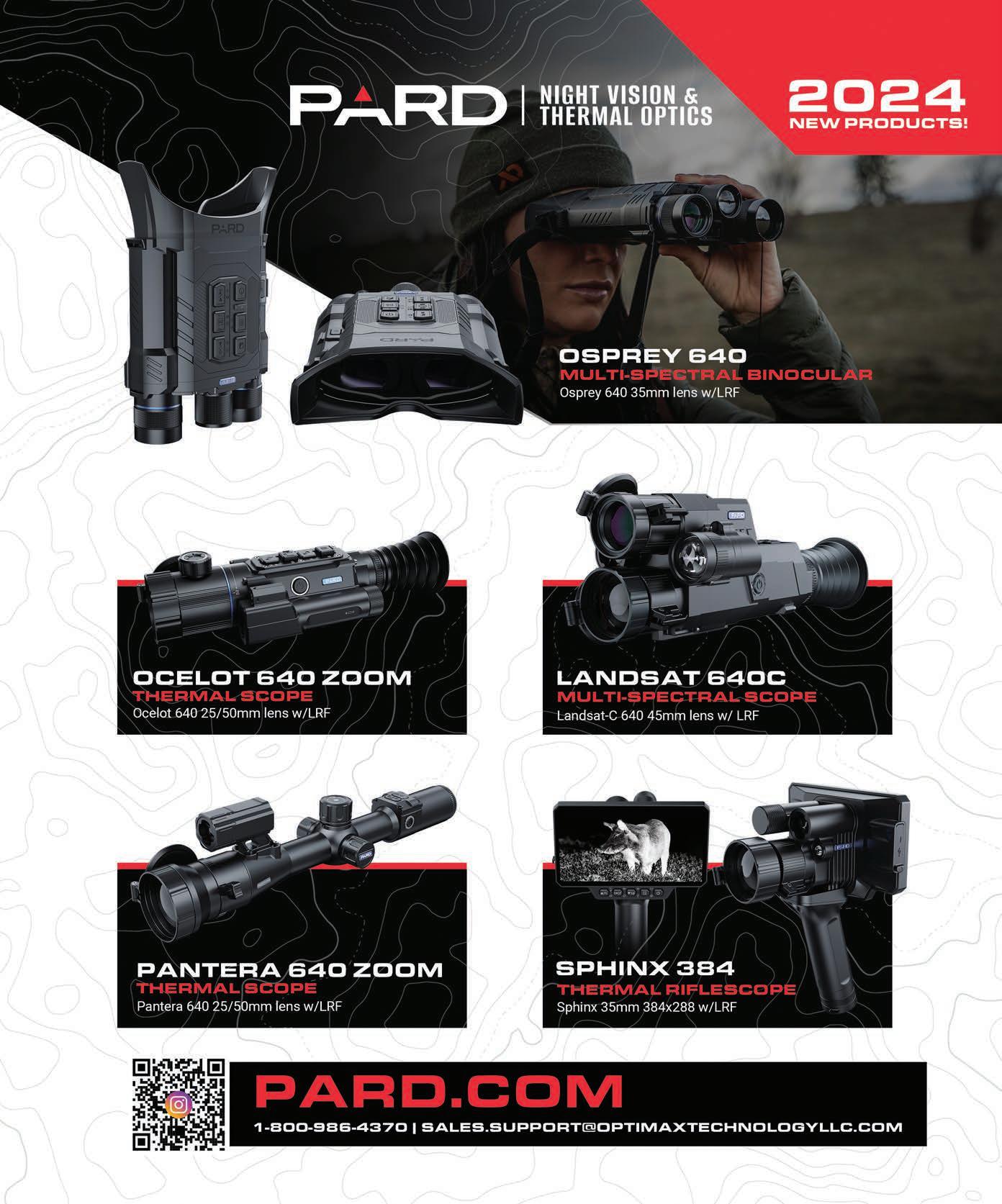





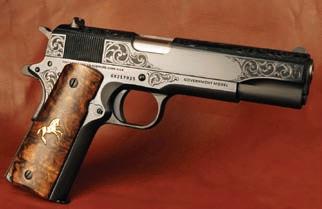

















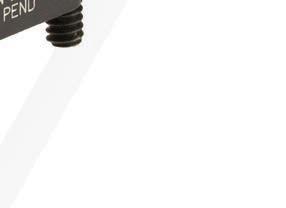

Instead of creating a closed emitter from scratch, we started with the Trijicon RMR (Ruggedized Closed Reflex) is designed with the RMR’s patented, durable housing and identical footprint—with a closed emitter and top-loading battery. See the new technology at Trijicon.com/RCR.




This issue’s cover brought to you by:

The market for thermal optics is hot, becoming increasingly popular and a significant revenue stream for dealers who carry premium optics, rifles, and accessories. While thermal optics have been around for some time, we are now witnessing better technology, faster innovation, and more aggressive pricing than ever before. For predator and hog hunters, the evolution of night hunting technology has been nothing short of remarkable. Over the years, thermal optics have seen significant advancements, with resolutions improving from 256 to 384, and then to 640. A few years back, InfiRay Outdoor, in collaboration with iRayUSA, introduced the first commercially available 1280x1024 resolution thermal optic. While groundbreaking, its $15,999 price tag placed it out of reach for most hunters.
In an exciting development, the latest advancements in thermal optics have made 1024-resolution devices more accessible and affordable. The TX60C thermal weapon sight, announced and displayed at the NRA annual meeting in Dallas, Texas, in May, represents the next leap forward in hunting technology. Unlike other options that offer 1024x768 resolution, the TX60C stands out with its superior 1024x1024 resolution, providing hunters with even sharper and more detailed imaging. Additionally, the TX60C features a 3x native (base) magnification, unlike other high-resolution optics that typically have a base magnification of 1.75x or 2x. This means that predator hunters can often use one less level of digital zoom and retain more resolution.
Priced at $6,999, the TX60C offers a compelling blend of performance and value, making it a highly
attractive option for serious hunters and shooting enthusiasts. Its advanced features not only enhance the hunting experience but also ensure clearer and more precise targeting. The optional laser rangefinder accessory and onboard ballistics calculator function further elevate its utility, offering comprehensive solutions for modern hunters.
InfiRay products in the United States, distributed through iRayUSA, come with the best warranty in the thermal optics industry: a five-year transferable warranty, with a five business day service turnaround guarantee. This level of commitment to quality and customer service sets InfiRay apart from the competition and provides additional peace of mind for buyers.
For businesses in the thermal optics industry, the TX60C represents a prime opportunity to meet growing consumer demand for high-resolution, affordable thermal imaging technology. As the market continues to expand, dealers can capitalize on the increasing popularity of night hunting and the desire for top-tier equipment. Stocking the TX60C allows dealers to cater to a wide range of customers, from
dedicated hunters to tactical professionals seeking the latest advancements in thermal optics.
The introduction of the TX60C also underscores the ongoing innovation within the thermal optics sector. As technology advances, hunters and shooting enthusiasts can look forward to even more sophisticated and accessible solutions. The TX60C’s impressive specifications and competitive pricing position it as a market leader, setting a new standard for what hunters can expect from their equipment.
The TX60C thermal weapon sight represents a powerful upgrade in the world of thermal optics. Its superior resolution, advanced features, and affordability make it a standout choice for hunters and a lucrative product for dealers. As night hunting technology continues to progress, the TX60C ensures that hunters are equipped with the best in thermal imaging, making every night hunt more successful and enjoyable. For dealers, it represents a significant opportunity to drive revenue and satisfy the growing demand for premium thermal optics.
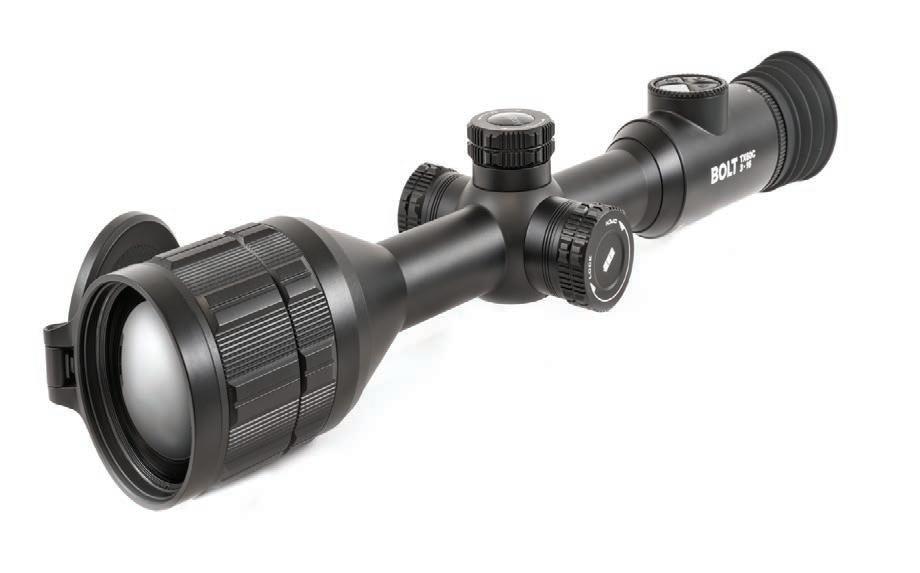
From grips to recoil pads, and holsters to body armor, Avient’s specialized polymer and composite solutions, forward-thinking design expertise, and customer-centric approach help you create products that always hit the mark.

For more idea inspiration, visit avient.com/outdoor or call 1.844.4AVIENT.
Night-vision and thermal optics are unquestionably technological marvels. They are also, unquestionably, well on the way to becoming mainstream accessories.
Em erging technologies, no matter what they may be, seem to follow a similar path: e arly products are complicated, fussy, overly large, and come with user manuals that for someone without a Phd in advanced physics might as well have been written in Assyrian cuneiform. Many years ago I tested an early GPS unit made by a manufacturer that has now receded from view. The thick user manual was indecipherable, and in order to use the unit I needed to get a fix on three satellites. I stood out in my front yard one night long enough for a neighbor to call my wife and ask if I was all right. She opened the kitchen window and asked, “Have you seen the saucers, yet? Come in; you’re spooking the neighbors.”
I found the same to be true with early versions of night-vision and thermal optics, to the point where I simply gave up trying to figure out how to use them.
B ut as Brian McCombie recounts in his article on these devices (Selling the Night, pg 32), a lot has changed. Initially, his early experiences
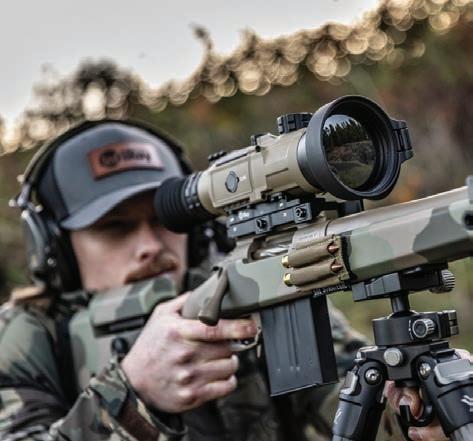
with these products was much like my own, but he now says, “Every thermal scope I’ve used in the last couple years possesses what is basically a one-shot zeroing system. Meanwhile, menu controls have gone to turrets that are more intuitive than the hard-to-feel button pads of the past.
“ S implification has also come to the other functions like changing to different reticles for the scope models to taking video and photos to adjusting image quality.”
That kind of progress means consumers are more willing to give these devices a fair trial. Selling these units, however, requires someone on your staff to truly know the ins and outs of each product. If you can’t explain precisely how a thermal or night-vision optic works, there’s no way you can close the sale.
O ne manufacturer told McCombie: “It is not the price or technology that holds dealers back—it is the sales, marketing, and product knowledge. Geek out on the product, learn it, and you can sell it very effectively.”
C rucially, as McCombie notes, you and your staff need to understand the critical differences between a thermal optic and a night-vision optic. Often “night vision” and “thermal” are used interchangeably to describe units that can help people “see” in low- to no-light conditions. Yet, in fact, they represent two very different technologies.
F inally, there is one more compelling reason to get into this business—margins. Another manufacturer said, “There’s also the obvious benefit of the efficiency of selling one high-end thermal product to make the same profit as selling a dozen guns or cheaper optics. I know which one I’d hope to focus on as a dealer.”
I like the way he thinks. You should, too.

Slaton L. White, Editor
EDITORIAL & CREATIVE
EDITOR w SLATON L. WHITE
GROUP MANAGING EDITOR w HILARY DYER
ART DIRECTOR w TOD MOLINA
ADVERTISING
SALES TEAM w DON HARRIS w TOBY SHAW w BRAD BISNETTE
COLE PUBLISHING ADMINISTRATION
PRESIDENT, COLE PUBLISHING w JEFF BRUSS PRESIDENT, GRAND VIEW OUTDOORS w DERRICK NAWROCKI
NSSF ADMINISTRATION
PRESIDENT & CEO w JOSEPH H. BARTOZZI
SENIOR VICE PRESIDENT & CCO w CHRIS DOLNACK
VICE PRESIDENT, MARKETING w BILL DUNN
SENIOR VICE PRESIDENT FOR GOVERNMENT & PUBLIC AFFAIRS, ASSISTANT SECRETARY & GENERAL COUNSEL w LAWRENCE G. KEANE
VICE PRESIDENT, HUMAN RESOURCES & ADMINISTRATION w DEB KENNEY
VICE PRESIDENT & CFO w JOHN SMITH
MANAGING DIRECTOR, MEMBER SERVICES w JOHN MCNAMARA
SHOT BUSINESS (USPS #xxx-xxx) is published six times a year: January/February, March/April, May/June, July/August, September/October, and November/December by COLE Publishing, Inc., PO Box 2707, Eagle River, WI 54521 and is the official publication of the National Shooting Sports Foundation, 6 Corporate Drive, Suite 650, Shelton, CT 06484.
All rights reserved. Contents may not be printed or otherwise reproduced without written permission of COLE Publishing. Periodicals postage pending at Eagle River, WI 54521 and at additional mailing offices.
COLE Publishing is not responsible for researching or investigating the accuracy of the contents of stories published in this magazine. Readers are advised that the use of the information contained within this magazine is with the understanding that it is at their own risk. COLE Publishing assumes no liability for this information or its use. COLE Publishing assumes no responsibility for unsolicited editorial, photography, and art submissions. In addition, no Terms and Conditions agreements are recognized by COLE Publishing unless signed and returned by the Editor.
POSTMASTER: Send address changes to: SHOT BUSINESS P.O. BOX 220, THREE LAKES, WI 54562.
ADVERTISING: Advertising inquiries should be emailed to shotbusiness@colepublishing.com. No responsibility will be assumed for unsolicited materials. SHOT BUSINESS is a registered trademark of NSSF. Contents copyright ©2024 by NSSF. All rights reserved. Reproduction in whole or part is prohibited unless expressly authorized by publisher.
MEMBER/SUBSCRIBER SERVICES: membership@nssf.org

Atthe time Smith & Wesson introduced the Model 1854 series, .44 Rem. Mag. was the caliber offering of choice. But now the rifle is also available in the iconic .45 Colt cartridge.
The Model 1854 series is designed to strategically blend the classic aesthetic of the American lever gun while incorporating modern enhancements. Models are offered in a paired synthetic black polymer and stainless-steel finish, as well as a walnut furniture combination with Armornite finish.
These rifles are designed with a 9+1 capacity, include a threaded 19¼-inch barrel and boast a crisp and smooth action that is also tough enough to stand up to use in the field.
The Model 1854 comes with additional features out of the box, such as a 4¾-inch Picatinny base for mounting optics, an adjustable XS Sights ghost ring rear sight, a gold bead front sight, flat-face trigger design, and removable magazine tube that allows you to safely unload the rifle.
(smith-wesson.com)


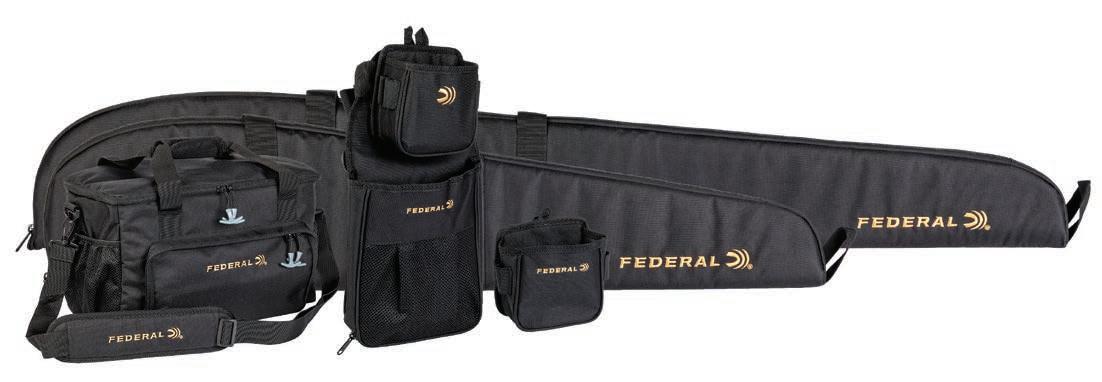


Federal Ammunition recently added a feature-laden lineup, including shotgun and scoped-rifle cases, to its extensive accessory group. All cases feature quality zippers, robust padding, and rugged, waterproof 600 denier polyester construction. This new line of accessories is now available at select dealers and online.
“Designed by hunters and shooters for the range, field, and blind, we now offer three new and distinct product lines to fulfill the soft gun case needs of any shooter or hunter: Top Gun, Field & Range, and Premium,” said Federal’s accessories product manager Jake Jacobs.
The Top Gun line features an affordable mix of six pieces: a single box pouch, a combo shell hull bag, a range bag, a 52-inch shotgun case, a 40-inch scoped rifle case, and a 48-inch scoped rifle case. All are decorated in a tactical black color. SRP: $11.99 to $34.99. Bags and pouches feature a padded back panel that provides structure and comfort. Firearm
cases feature protective foam padding, single-pull zippers, large hanging loops, and durable fabric lining that lets the gun slide in easily.
In addition, the Federal Neoprene Gun Sleeve delivers excellent, discreet protection to keep long guns safe from the elements. Its 53-inch length fits most long guns. It also features a drawcord closure and a reinforced muzzle end, and it rolls up for easy, compact storage. SRP: $34.99.
“Our Field & Range firearms cases meet the mid-tier price level, and we offer either camouflaged or stylized gray gun cases in this new lineup,” says Jacobs. Features and benefits of Federal’s Field &

Range product line include rugged, long-lasting fabric; protective foam padding that floats loads up to 12 pounds in weight; durable fabric lining that lets a gun slide in easily; easy-to-grab double zipper pull; padded web carry handle; an easy-grab zippered accessory pocket with structured lid; a detachable, adjustable sling with large EZ swivel clips; and a large, easy-to-grab hanging loop.
The product line includes four pieces: a 78-inch shotgun case in Realtree MX7, a 52-inch shotgun case in Realtree MX7, a 48-inch Scoped Rifle Case in gray, and a 48-inch scoped rifle case in gray. All feature black trim or accents. SRP: $59.99.
In addition, The Federal Tri-Fold Gun Case folds down for easy storage and is built with rugged, long-lasting material that keeps firearms safe. This case protects firearms during transport without having to deal with bulky gear. It features rugged, long-lasting fabric; protective foam padding; a foldover flap with an adjustable quick-release buckle; durable fabric lining that lets the gun slide in easily; an adjustable length sling with sliding pad; reinforced muzzle end; and a D-ring hanging loop. SRP: $39.99.
Features and benefits of Federal’s new line of Premium gear include 18-ounce waxed canvas; durable leather-reinforced accents; leather-wrapped, heavy-duty cotton web handles; and brass hardware. Firearm cases feature quilted padding, durable easy-slide lining, a double zipper pull opening with leather tabs, an exterior accessory pocket, and an adjustable and removable carry sling.
The product line consists of six pieces: a shell pouch, a range bag, a 48-inch shotgun case, a 52-inch shotgun case, a 44-inch scoped rifle case, and a 48-inch scoped rifle case. All are decorated in an attractive, traditional tan color. SRP: $54.99 to $159.99.
(federalpremium.com)


Southwick Associates, a market research and economics firm that specializes in the hunting, shooting, sportfishing, and outdoor recreation markets, has released the 2023 Hunting & Shooting Market Size Report. This report details the size of the more than $22 billion hunting and shooting equipment market in 2023. The overall market value dropped from 2022 estimates, but was still higher than prepandemic levels, with firearms and ammunition declining less than anticipated.
“Consumer purchases of firearms and ammunition was stronger than expected in 2023, as dealers continued to work through inventory and re-align product assortments,” said Nancy Bacon, vice president of Southwick Associates.
“Inflationary pressures continue to affect the consumer, but they appeared to be resilient in 2023 with increases in hunting and shooting accessories that may not have been broadly available in the last couple of years. The new market size report will help businesses understand the new market environment, and identify opportunities.”
The new “2023 Hunting & Shooting Equipment Retail Market Size Report” is available to purchase from Southwick Associates.
The report includes both retail unit and dollar sales estimates of more than 80 products directly associated with hunting, recreational shooting, and personal protection. Breakouts are included for specific product attributes such as action type or caliber/gauge, the primary purpose for consumers’ purchases, and more. Only equipment directly associated with
hunting, recreational shooting, and personal protection are reported. Other items such as travel-related spending, real estate, and indirect equipment such as vehicles are not included.
Custom research into specific market niches is also available, as are reports identifying the top brands, sales by retail channel, and more.
(southwickassociates.com)

Springfield Armory has launched the 1911 DS Prodigy Comp AOS 9mm in 5-inch and 4.25-inch variants. Both pistols are integrally compensated to reduce felt recoil and muzzle rise, and they combine the most beloved characteristics of the 1911 with modern capacity for unrivaled performance.
The integral compensator on the Prodigy Comp is discreetly designed, featuring a single port on the top of the hammer-forged slide and barrel. By redirecting gas upward, it reduces muzzle rise and enhances control, allowing for faster and more accurate follow-up shots. Additionally, the pistols feature a tritium front sight positioned behind the compensator to ensure an uninterrupted sight picture.
The Prodigy Comp takes the proven 1911 platform and enhances it with double-stack capacity and a performance-driven feature set. Configured around a double-stack magazine, the polymer grip module of the 1911 DS pistol mounts to a forged steel frame, offering capacities of 17+1 and 20+1.
To allow the ease of use of today’s most popular red-dot optics, the Prodigy Comp features slides cut for AOS (Agency Optic System) plates. Developed in collaboration with Agency Arms, these billet steel plates deliver proper optic height for intuitive sight picture and instant target acquisition; they also feature an integral rear sight. The Prodigy Comp ships with a HEX Dragonfly-compatible plate as well as a cover plate; additional optic-specific plates are available for purchase.
“The Prodigy pistol has proven to be very popular with shooters looking for the appeal of the classic 1911, but with enhanced double-stack magazine capacity and modern features,” says Steve Kramer, Springfield Armory’s vice president of marketing. “The flat-shooting Prodigy Comp adds the benefit of reduced muzzle flip and faster follow-up shots to an already highly capable design.”
Each pistol comes with two magazines—one 17-round flush-fit and one 20-round extended, with optional 26-rounders available for purchase. In addition, restricted-locale 10-round variants of both models are available. SRP: $1,599. (springfield-armory.com)
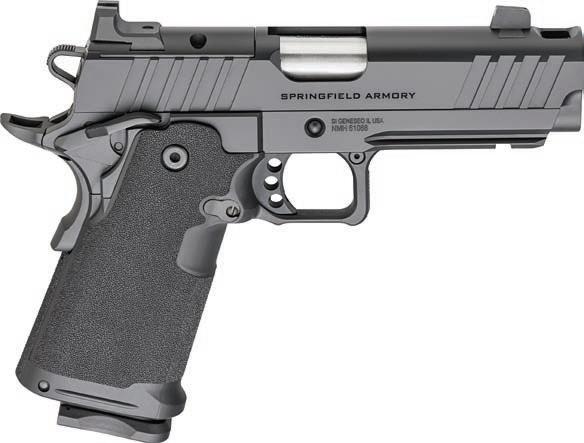



Tetra Gun has developed a new grease formula called Obex Prime in order to offer something that meets or exceeds the specifications of NSN-grade lubricants that are already approved for use on medium-caliber weapons systems. For the sport shooter, that translates into elite performance characteristics out of any gunmetal treatment.
This proprietary Obex Prime grade 1 light grease is applied sparingly; the fluoropolymer-based lubricant protectant penetr ates and coats gun parts, providing an environmental barrier from fouling that ensures minimal friction and wear while assuring the user a maximum number of rounds fired before re-lubrication.
“Whether it ’s applied to handguns, rifles, or shotguns, you can literally feel the difference of maintaining a fire-ready condition,” says Greg Cohen, president of Tetra Gun. “Our proprietary technology is rooted
in a scientific breakthrough that took the military by storm decades ago and is even better today.”
The Tetra difference is the super small, specially treated spherical particles of fluoropolymer that create that ball-bearing smooth surface that stands up to extreme conditions. That, combined with the other specialty ingredients, gives the user a concoction that delivers unmatched performance.
Cohen says Obex Prime operates at an extreme operating-temperature range while delivering serious pressure and load bearing tolerances. It also prevents galvanic corrosion. “It’s also long lasting, with no known shelf life. Furthermore, it’s made in the USA.”
Tetra Gun Obex Prime is available in a one-ounce tube. SRP: $14.99.
(tetraguncare.com)

The first Kids & Clays shooting sports event to benefit families in need launched in 1999 with the support of Winchester Ammunition. It now has grown to be a major fundraiser for participating Ronald McDonald House Charities (RMHC) chapters across the country. To date, more than $3.6 million has been raised by good people who enjoy the shooting sports and have a heart for children and their families—and it is a news story that hasn’t been trumpeted loudly enough.
“Our long-standing commitment—25 years—as a major ammunition supporter to Kids & Clays is extremely important,” says Brett Flaugher, president of Winchester Ammunition. “We are proud that our brand of more than 150 years is associated with organizations like Kids & Clays and that we can help further their mission.”
In 1999, Glenn and Kathy Lubeznik, McDonald’s owner/operators in northwest Indiana, chaired the first annual Sporting Clays Tournament Event benefitting the Chicago Ronald McDonald House. With the support of Winchester Ammunition, McDonald’s owner/operators, and McDonald’s suppliers, the event hosted 137 participants and generated more than $15,000 for the House.
The next year, companies and organizations such as Browning, the National Shooting Sports Foundation (NSSF), and the National Sporting Clays Association (NSCA) followed Winchester’s lead and agreed to support the event as sponsors. More than 220 participants shot in the Chicago tournament, and the Chicago Ronald McDonald House was again the beneficiary, to the tune of more than $58,000.
The rapid success of the Chicago area tournament inspired Lubeznik to share his knowledge of this fundraiser with Ronald McDonald Houses across the country. Because of the potential for growth of this program, Lubeznik formed what is known today as the Kids & Clays Foundation. The Foundation’s goal was to promote shooting tournaments as a unique type of fundraising event for Ronald McDonald Houses across the nation. Each year, Winchester donates thousands of dollars of ammunition and merchandise to support nearly 50 Kids & Clays events. The local RMHCs keep 100 percent of the net proceeds from each event. What started as tens of thousands of dollars annually in fundraising has grown exponentially with 2023 setting a record high of nearly $3.6 million all to help critically ill children from coast to coast. (winchester.com)

by b rian M c c o
Trijicon manufactures a wide selection of variable scopes that cover pretty much all rifle-shooting applications. Those include hunting (longer range and up close), competitive shooting where the targets can be more than 1,000 yards distant, 3Gun rifle, and recreational shooting.
Trijicon variable scopes also fill the niche for the tactically oriented consumer and are in use by a wide variety of military and law-enforcement units.
Not surprisingly, Trijicon’s current best seller is a variable, the Credo 1-10x28mm scope. Launched at the 2024 SHOT Show, the Credo 1-10 features a first focal plane design and a tough 34mm tube. The segmented, enhanced circle reticle puts shooters on target fast, both close and at distance, and is available with either red or green day and night illumination. The scope adjusts at 0.1 MRAD per click, elevation and windage, and measures out at a very nifty 10.1 inches long. The Credo 1-10x28mm became an instant hit with tactical, personal defense, and competition shooters.
Currently, Trijicon’s variable riflescope lines encompass seven discrete models. AccuPoint scopes are engineered for hunters who want battery-free, tritium, and fiber-optic illumination that is always on. Like all Trijicon optics, AccuPoints feature crystal-clear lenses for a brilliant sight picture and zero distortion. Available with eight reticle options and green, red, or amber illumination, the AccuPoint line encompasses nine different models, from 1-4x24mm to 5-20x50mm. With up to 100 MOA or 29 MRAD of adjustment, the AccuPoint riflescope delivers ultradurable construction with both-eyes-open shooting at any range. The newest models include the 3-18x50mm and 4-24x50mm.

The author on a successful West Texas deer hunt using the Trijicon AccuPoint 3-18x50 scope.
seven reticles, including red and green illuminated options. Exposed elevation adjusters with zero stop allow for easy zeroing. Both Credo lines include repositionable magnification levers. The newest model here is the Credo HX 1-10x28mm, a hunting cousin to the more tactical Credo 1-10.

best-selling Credo 1-10x28.
The AccuPoint 4-24x50 scope features battery-free, tritium, and fiber-optic illumination.

Tactical shooters will find much to like in Trijicon’s Ascent line, including 1-4x24mm and 3-12x40mm offerings with a BDC (Bullet Drop Compensator) target hold MOA-based reticle. Both scopes are second focal plane builds. Tested to military standards and featuring low-capped adjusters with ¼ MOA clicks, Ascent scopes feature fully multi-coated, broadband anti-reflective glass for excellent light transmission and brilliant edge-to-edge clarity. Built on aircraft-grade aluminum 30mm tubes and weighing less than 17.8 ounces, Ascent riflescopes sport both a matte finish and turrets with tactical knurling for responsive adjustments. Featuring user-selectable green or red LED illumination, Credo tactical riflescopes deliver any-light aiming and superior target acquisition from a ruggedly durable platform. A result of technology that’s been honed over decades of actual military deployments, the Credo line is available with ten different illuminated reticles in various MOA, MRAD, or BDC configurations. The eight Credo scope options range from 1-4x24mm to 4-16x50mm and are available in first or second focal plane reticles.
Designed for hunters, Credo HX scopes are built to handle the hazards of tough hunting in challenging conditions. The seven Credo HX models offer rapid target acquisition from dawn to dusk thanks to high-quality lenses and
Trijicon designed and constructed the Huron variable-power scopes exclusively for the North American deer hunter, and they feature high-quality glass and the same military-grade construction shooters expect from Trijicon. Available with three uncluttered reticles that deliver fast and accurate shots, the Huron riflescope is available in 1-4x24mm, 2.5-10x40mm, 3-9x40mm, and 3-12x40mm variants, with either a 30mm or 1-inch main tube, depending on the model. Offering up to 100 MOA of adjustment, Huron riflescopes utilize low-capped, easy-to-use adjusters with ¼ MOA clicks for consistent, snag-free elevation and windage adjustments that keep their zero.
Trijicon built its Tenmile riflescopes for long-range enthusiasts. These optics feature seven different illuminated reticles in MRAD or MOA configurations. Available in six variable-power scopes from 3-18x44mm to 6-24x50mm, in first and second focal plane models, the models sport 30mm and 34mm tubes. The eight reticle options are all LED powered by a single CR2032 lithium battery. The Tenmile offerings allow for up to 100 MOA or 29 MRAD of adjustment from crisp and precise adjusters.
Last, for those hunters who like to go long, Trijicon makes the Tenmile HX, which features four green or red illuminated reticles, three variable power choices, outstanding glass, and rugged 30mm tube construction. It is available in MOA and MRAD configurations. For 2024, Trijicon added a first focal plane version of the 5-25x50mm model.
Given all those options, your customers should be able to find a Trijicon scope with the features they need—and at a reasonable price point.
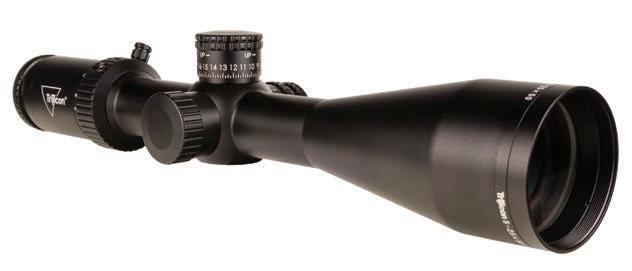
Trijicon’s newest addition to the Tenmile HX line, the 5-25x50 riflescope.



Christopher DiCenso CEO, SDS Imports
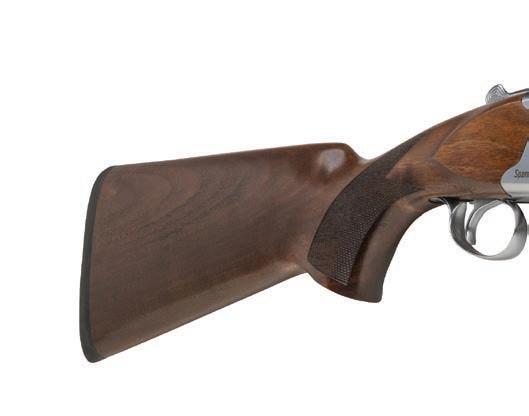

SDS Imports specializes in products that deliver both affordability and performance.
Based in Knoxville, Tennessee, SDS Imports is a firearms importer that began operations in 2017. The technical and logistical support—including engineering initiatives, compliance expertise, and marketing efforts—the company offers its global partners helps them to successfully navigate the intricacies of the diverse American market. Brands under the SDS banner include Tisas USA, Tokarev USA, Military Armament Corporation, Spandau Arms, and Inglis Manufacturing.
Recently Christopher DiCenso came aboard as the company’s CEO. He brings more than 30 years of experience to SDS and was most recently a Managing Partner at Growth Strategy Partners, where he specialized in helping mostly firearm and related companies accelerate their revenue, profit, and organizational growth. He began his career as a manufacturing engineer at Sturm Ruger. In addition, he is a former president of Camfour. DiCenso is an avid shooter and competes regularly in IDPA, USPSA, and 3-Gun matches.
SHOT Business: What do you see as the biggest challenges facing the industry in the next five years?
Christopher DiCenso: The big challenge is perception versus reality relative to the use of firearms. You have the narrative by the uninformed or uneducated that firearms are bad. I’m an engineer by
facts. The facts are we are part of a great sport. Firearms are a tool, and they don’t do the all the “bad things” that people say they do. To me, the challenge for our industry over the long haul is to change that perception. I often ask people if we’re going to have an emotional or logical discussion, so I know. The good news is that the U.S. Supreme Court seems to lean more toward fact rather than perception in their decision making.
SB: What opportunities do you see?
CD: With challenges comes opportunity. As an industry, we need to improve how we get out the message about the realities of the use of firearms. Our industry brings money to conservation through the use of sporting firearms, and we help people defend their homes and families. We also provide well-paying jobs that help people support those families and their communities.
SB: When you get up in the morning, what gets you excited about working in the industry?
CD: I half joke with friends and family that I play with guns all day long. But, really, that’s it. I started shooting in college. I love the sport. I shoot competitively. It’s my hobby. Given my engineering background, I like solving problems and I like building teams, and I’ve found that I do both pretty well. When I can help individuals on our team perform at a higher level and solve problems, that’s rewarding for both me and the team.
SB: Many dealers continue to complain about supply chain issues. What’s your take on this?
CD: I’ve worked in many other industries, and our supply chain can be improved dramatically. Dealers often place an order from three or four different wholesalers for the same product, and then they cancel two of those orders when they get what they want. That’s not a sign of an effi -
The Spandau Premier Field over-under is a good example of Turkish craftmanship, but it sells at a far more affordable price point than many other over-under shotguns.

entire system would benefit if we worked more collaboratively on sales and product planning. When that happens, business profits should go up and consumers will be happier. But right now, we’re all guessing. We need to be more data driven. NASGW has a data base that captures all the wholesaler shipments. You can see who is buying what by brand, model, and type. That historical data should be a good way to forecast the future.
SB: In a very competitive world, how does SDS Imports stay ahead of the pack?
CD: With us, it’s really about getting the message out that we offer really good products at much more affordable and competitive prices than our competition. We specialize in bringing in firearms made in Turkey. As a result, our cost structure allows us to offer these products at a much lower price point. Double-stacked 1911s are very popular right now, and we’ve got one made in Turkey by MAC [Military
The SRP is $1,100. One of our competitors offers a comparable product for around $1,400; another company offers essentially the same gun for $2,500. I’m shooting a MAC gun in competition right now, and it performs at a very high level.
SB: How do you keep your dealer network informed of your new products?
CD: We have a direct sales force, so our sales reps are out visiting our dealers every week. That one-to-one relationship is the best communication there is. Our reps are educating dealers on our current products as well as what’s coming down the line. We place a lot of emphasis on education. Having worked previously in wholesale I have learned that a lot of people in this industry sell what they know and what they’re comfortable with. In order to get them to sell something different, you have to educate them. That’s what our sales team does, and I think they’re doing a great job.
SB: Recently SHOT Business published an article on 1911s. In discussing custom models that often sell for $2,500, the author mentioned a more

The Tisas Duty R series is a full-size 1911 pistol with an integrated Picatinny rail. It also has a skeletonized hammer and trigger and ambidextrous safety.
affordable, but well-built alternative: 1911s from Tisas. How has Tisas been able to accomplish this?
CD: The short answer? Lower cost. But lower cost doesn’t mean “cheap.” There is a perception that Turkish-made guns are cheaply built. That’s not true. Here’s the analogy I use: Years ago people thought Japanese electronics were “cheap” products. Well, there were offered at lower cost, but they certainly weren’t “cheap” products. They were quite good.
What many may not know, based on the latest data I have from 2022, Turkey is the largest exporter of firearms into the United States. SDS was a customer of mine at my last job with a wholesaler, so I knew what they were doing, and I knew that these guns were quite good. Turkish guns are well built, but we benefit from a lower cost structure that allows us to pass those savings on to the consumer. And I’m not talking about 10 to 15 percent; I’m talking about 30 percent—and in some cases 50 percent—less expensive than our competition. I recently shot a sporting clays event with one of our Spandau over/unders with an SRP that starts at $1,000 and runs up to $2,200. These guns are very well made and they shoot very well. If you had your eyes closed when you shot it, you would think you were shooting a shotgun that cost $3,000 or $4,000. When you combine affordability with performance, you’ve got a winner. (sdsimports.com)

The MAC 1911-9 Double Stack, chambered in 9mm, features a factory RMR-pattern optic cut on the slide and M1913 light rail on the frame.

Baron Engraving can make an ordinary firearm into something very special.
It’s no secret that there’s no secret to running a successful business. Anyone who owns a profitable business knows that there are very specific principles and practices you have to consistently apply to be successful. One of those practices is the ability to make your business, and your products, stand out from the competition.
For gun store owners, that’s often easier said than done. After all, almost every gun store across the country is carrying a relatively similar inventory of the most popular firearms on the market. Fortunately, Baron Engraving has a solution that makes standing out from the competition as easy as it is profitable.
“By adding custom engraving to stock firearms, we can make a ‘me-too’ gun into something really special,” says David Miles, president and CEO of Baron Engraving. “And not only does it make that firearm stand out, it also gives retailers higher margins than they get on the stock gun.”
To make this proposition even more attractive, Baron has three different options available
to retailers, so they can sell custom engraved firearms in a way that works best for their business—and their customers.
The first—and easiest—option is to order a selection of firearms that are pre-engraved by Baron. “We’ve been in business for more than 40 years, and we’ve developed strong partnerships with all of the major firearms manufacturers,” says Winslow Potter, vice president of sales and marketing for Baron.
These long-term relationships that Baron has forged over decades means that when a manufacturer wants to do a run of custom-engraved firearms all they have to do is send Baron a run of a pre-determined number of firearms. Baron will engrave them with artwork created around a specific theme.
A great example is the Grade III Engraved Colt 1911 Government model that Baron featured at this year’s SHOT Show. “This is a turnkey custom pistol that retailers can get directly from their distributors to make it easy for them to personalize their offering and give their customers something that is truly special,” Potter
says. “Basically, these come in as stock guns and they leave with all the glitz and glamour of custom firearms.”
Retailers can get the Grade III Engraved Colt 1911 Government model in either stainless steel or blued versions, both of which come with standard Colt wood grips.
“Guns like this give retailers a way to set themselves apart,” Miles says. “It helps bring people into their stores, and it attracts higherend customers—especially collectors—who are looking for something more than a stock gun. It’s also a great way to get repeat business because those customers are going to keep coming back to see what other customized firearms you carry.”
To give those customers a prized firearm that’s even more attractive, Baron’s custom shop provides unlimited options for personalizing the custom-engraved 1911 even further by offering specialized engraving on the left and right slide panels of the pistol. With this option, retailers— or even organizations, foundations, and specialty groups—can take a firearm that’s already custom-engraved and turn it into a treasured pistol
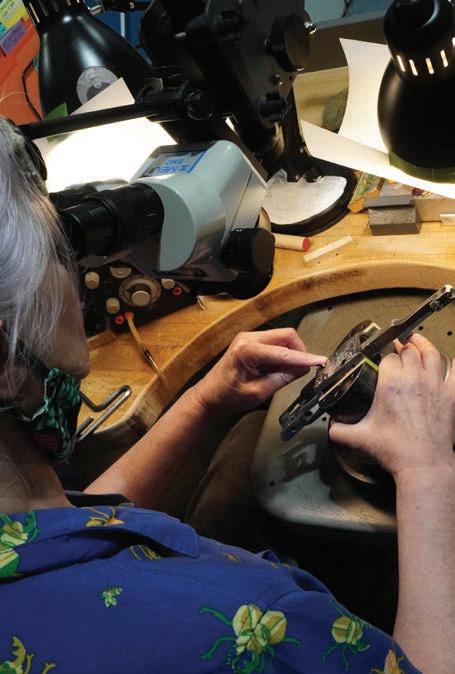


Retailers can get the Grade III Engraved Colt 1911 Government model in either stainless steel or blued versions, both of which come with standard Colt wood grips.
that customers or members couldn’t get anywhere else. Baron offers these special-order 1911s with a variety of custom grip options, including Turkish walnut with a gold rampant

pony, kirnite presentation white grips, and custom diamond walnut or rosewood laminate grips with engraving and text.
For a truly unique option, Baron also has the capability to personalize the 1911, and a wide range of other items, with nearly any design, etching, or wording that your customers are interested in. “Most of our business is guns, but we can apply our technology to almost anything,” Potter says.
And the technology Baron has developed over the past four decades is considerable. “We incorporate all types of engraving into our
In business for more than 40 years, Baron Engraving constantly upgrades its engraving machinery.
designs,” Miles says. “Every form of engraving you can think of we have available in-house, and we’re always looking for new technology to bring to the table.”
Miles fully admits, however, that not every custom firearm Baron creates makes it all the way to retailer’s shelves. “It’s been pretty common over the years that I work on a project and then have to have one for my own collection.”
Considering the quality of work Baron turns out, it’s not hard to understand why.
(baronengraving.com)

If you measure only twice to cut once, congratulations, you’re not obsessed like we are. Here at our ballistic lab we stop at nothing to test every conceivable real-world condition until we reach perfection.
by Robert Sadowski
The new normal in LPVO (LowPowered Variable Optics) riflescopes is 1-8X or 1-10X power. That’s a lot of magnification for a compact scope that offers a compromise between fast, close target acquisition and hitting targets out to medium range. Both FFP and SFP models are available. For pistols the red-dot optic market is still hot with enclosed LED emitter red dots. These are models that look like a mini black box mounted to the pistol slide. Binoculars and spotting scopes continue to evolve with many rugged models at affordable price points. The next big hot item is thermal scopes, some of which even we mere mortals can afford. Here are the details.
The Edge 1-10x24mm LPVO (SRP: $1,600) is designed for dynamic carbine and tactical applications. Features include locking zero stop turrets with 40 mils of internal travel, fixed parallax at 150 yards, integrated removable throw lever, and an oversized zoom ring for easier manipulation with gloves in cold-weather conditions. The reticle is the Hybrid Combat Reticle developed with input from top 3-Gun competitors, hunters, and Special Forces operators. The new Apex Hunter 3-15x44mm riflescope (SRP: $1,200) is a hunting riflescope made for the precision rifle shooter. The exclusive HLR (Hunter Long Range) reticle is deadly accurate for both close-up and extended-range hunting scenarios. Available in both illuminated and non-illuminated versions. The Summit ED Binocular is available in two models, a 10x42mm (SRP: $500) and 12x50mm (SRP: $850) built for hunters and precision rifle shooters. Both models feature Japanese ED glass for clarity of picture and edge-to-edge crispness. The 12x50mm model features a rotating mil reticle. All models include a four-point chest harness for ease of carry.
(apexopticsco.com)


The new Vudu X Series of riflescopes is designed to meet the demands of shooters whether it’s 3-Gun competition, hunting, or recreational shooting. Models include a 1-6x24mm (SRP: $799) and 2-12x40mm (SRP: $849). Both feature a 30mm tube diameter, illuminated SFP reticles powered by a CR2032 battery, and a removable throw lever for quick transitions across the magnification range. Available reticles include the PD1 duplex style or BD1 that provides additional circular ballistic hold adjustments. Turrets are capped and feature MOA adjustments and zero reset.
(eotechinc.com)



The popular Rangeguide binocular lineup now includes two new rangefinding binocular models in 8x40mm (SRP: $1,300) and 10x40mm (SRP: $1,300). These new 40mms feature a magnesium frame that decreases the weight and increases the strength. In addition, both can range out to 3,500 yards. True range-angle technology calculates the proper distance to the target after measuring the angle to the target, providing a precise inclination/declination compensation reading. The new Passion SD binocular line includes six new models ranging in size from sub-compact: 8x26mm (SRP: $299), 10x26mm (SRP: $299); compact: 8x34mm (SRP: $349), 10x34mm (SRP: $349); and mid-sized: 8x42mm (SRP: $399) and 10x42mm (SRP: $399). The SD line offers high-resolution, high-transmission optics in a small, lightweight package suitable for budget-conscious buyers.
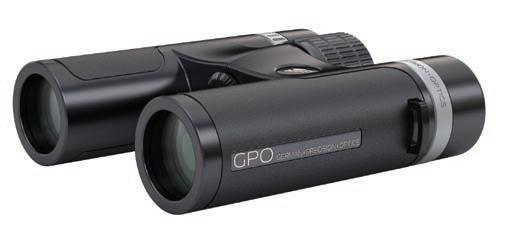
(gpo-usa.com)
When the situation demands up-close speed and precision, the new CMR8 Close to Medium Range 1-8x24mm (SRP: $399) riflescope is the solution. A b-Dot fiber-optic illuminated reticle provides a true daylight-bright center dot calibrated for .223 and .308 and offers precise reference marks up to 600 yards with a 50- and 200-yard zero.
(hi-luxoptics.com)


The InfiRay Outdoor RICO HYBRID fuses the capabilities of a thermal clip-on and a thermal weapon sight to create a new breed of thermal device. New for 2024 is the HYH75W—the 75mm variant of the HYBRID. This new model expands upon the already advanced feature set of the current 50mm model. In addition to the larger objective lens, the newest model of the HYBRID family sports a flat dark earth Cerakote finish. The HYBRID provides versatility and performance as well as compatibility with day optics up to 10X as an inline clip-on sight. The combination of the HYBRID’s low-distortion eyepiece and a 1.03-inch large-format 2560×1920 AMOLED display provides comfortable viewing as a dedicated sight while still maintaining the pixel density and resolution required for use as a thermal clip-on. The HYBRID boasts advanced features such as compatibility with a 1,000-yard laser rangefinder, a custom reticle generator, and an onboard ballistic solver. This allows the user to detect a target in the dark, determine its range, calculate a firing solution based on that range, and display a hold point in the custom reticle. The HYBRID exemplifies the crisp image quality for which InfiRay products are known and comes with all the features night hunters prize: photo/video/audio recording, mobile streaming over Wi-Fi, and, of course, the iRayUSA five-year warranty. (irayusa.com)


Laserwork’s LW809 10x42mm OLED binoculars can range targets out to 4,000 yards. BAK-4 prisms produce clear and sharp images, and the aluminum-magnesium housing provides maximum protection of internal elements. The LW209 laser rangefinder is a recoilresistant rangefinder add-on accessory that can attach to different scopes with the included adapters. Available in 8x42mm, 10x42mm, and 12x42mm versions, the rangefinder has a reach of up to 1,600 yards.
(laserworks.com)
The new INTEGRIX iX6 series includes a 3-18x44mm FFP mid-power scope (SRP: $1,599.97) and a 4.5-27x56mm FFP high-power scope (SRP: $2,199.97), both of which showcase the high quality standards of the INTEGRIX brand. The mid-power scope is available with either an A2 MOA German duplex-inspired reticle or the M1 MRAD reticle, a tried-and-true Christmas tree-styled reticle made for long-range shooting. The high-power scope comes with either the M1 MRAD reticle or an M2 MRAD, which is a modernized and minimalist reticle designed for tactical use. Both scopes are rated for .338 LAPUA Magnum, have red and green reticle illumination with eight brightness settings, and a 12-hour automatic shutoff. Side-adjustable parallax is from 30 yards to infinity. The new ACCUSHOT PRO optics line has a similar build quality and feature set to that of the INTEGRIX line, but at a lower-cost entry point. Two models are available: the AS6 1-6X24 FFP and the AS6 1-6X24 SFP. The first focal plane scope is available either as an A1 MOA or B1 BDC reticle; the second focal plane scope features an A3 MOA reticle designed for the IPSC rifle shooter. (leapers.com)



















Protecting your rights has never been more important than it is today. Our national crisis has exposed the politicians who want to strip away our constitutional freedoms.



In many places, you don’t have to wait until Election Day. Learn how to take advantage of absentee ballots and early voting in your state!
Make Your Voice Heard Today!
It is crucial that firearm retailers become informed about candidates’ positions and spread the message about this year’s #GUNVOTE at every possible opportunity.
What can you do to help?

• Download and display NSSF’s #GUNVOTE icon on your website and social media pages.
• On Election Day, #GUNVOTE!
Follow #GUNVOTE on:





• Encourage your customers and employees to register to vote.
• Visit nssf.org/gunvote and encourage others to do the same.



March’s wide-angle scopes have evolved into GenII. The 5-42x56mm FFP scope (SRP: $4,490) was developed for long-range shooters and hunters with 130 MOA/40 mil elevation travel perfect for long-range shooting. It also features a Temperature Anti-Drift Lens System that naturally adapts to temperature changes and maintains focus and clarity under a variety of conditions. The wide 26-degree field of view is a 30 percent increase over the standard model, allowing shooters to find the target faster. Lockable elevation, windage, and side-focus turrets are upgraded with shuriken-shaped (think ninja throwing knives) locking turrets for a sure grip and tactile feel. (marchoptics.com)
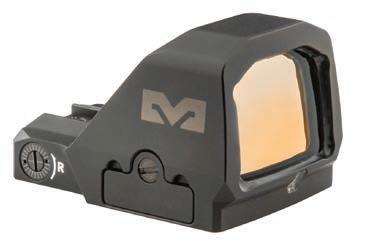
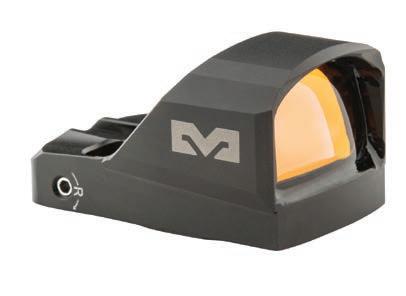
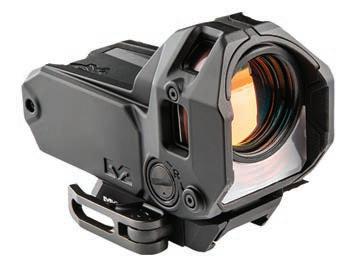

Built to endure direct impacts and operate in the harshest conditions, the MPO Pro-S provides heightened accuracy and an exceptional field of view. It features a user-selectable three- segment reticle system (3 MOA dot, 33 MOA bullseye, and 33 MOA ring) that allows the shooter to choose how they interact with their optic. Other features include automatic and manual brightness control and a power-saving sleep mode. In addition, it effortlessly integrates with existing industry-standard RMSc/JPoint footprints.
The Mepro MPO-S is engineered with a sleek, low-profile design that minimizes the risk of snags, ensuring a faster draw and quicker target acquisition. Features include user-friendly buttons, a standard CR1632 battery offering 2.5 years of illumination, and a selectable threesegment reticle (3 MOA dot, 33 MOA bullseye, and 33 MOA ring). A RMSc/JPoint footprint allows for direct mounting to your favorite concealed carry handgun.
The Mepro MPO-DS is an open reflex red dot sight designed for subcompact pistols. This cost-effective optic features a 3.5 MOA red dot reticle, RMSc/JPoint footprint, automatic brightness control, and a CR2032 battery that lasts for three years. It is also water- shock-, and fog-proof. The similar-featured Mepro MPO-DF is an open-reflex red dot sight specially designed for full-size pistols.
The Mepro MMX3 and Mepro MMX4 are compact and lightweight micro magnifiers that can extend the range of a red dot or 1X reflex sight. They attach to any mil-std 1913 rail directly behind the optic. When not in use, they can be flipped out of the way by depressing a push button.
The new Mepro M22 is the next generation of the legendary Mepro M21 reflex sight, used for decades by the Israeli Defense Force as well a militaries and law-enforcement agencies worldwide. Smaller and more compact, the Mepro M22 is a reflex sight with fiber-optic illumination by day and premium Swiss-made tritium vials by night that will operate in any lighting condition with no need for batteries. The transition between the two systems is instantaneous and automatic. Its rugged, battle-proven construction meets or exceeds rigorous standards to function in the harshest environments.
(meprolight.com)
The DS37-LRF 4K uses PARD digital imaging technology to combine a 4K high-definition night-vision sensor, a ballistics calculator, and a laser rangefinder into a single unit. The DS37-LRF 4K features a 4096x2160 resolution night-vision sensor with a 70mm lens (providing 9.7°x5.1° FOV), 2X optical magnification, 2X digital magnification, and sensitivity down to .001 lux. Available in 850nm wavelength, the VCSEL IR illuminator has three levels of intensity and directional beam focus out to 500 meters.
Users will enjoy rich contrast and bold resolution when acquiring (and accurately ranging) targets with the 1,200-yard integrated laser rangefinder (LRF) that seamlessly feeds the data into the on-board ballistics calculator. Daytime or nightvision images are displayed on the 800x800 IPS LCD display. Optional 2X magnified picture-in-picture (PIP) function provides clear night-vision depth perception and target recognition. Display options include six individual reticle styles, three different reticle colors (white/yellow/green), and four different color modes (color/mono black and white/mono green/mono yellow).
Additional features of the TDS37-LRF include a removable 128GB Micro SD card that allows the user to capture 4096x2160 photo images and 1920x1080 resolution video, Wi-Fi connectivity to a PC, tablet, iOS, or Android device through the use of the free PARDVision app, and USB Type-C and HDMI output connections. SRP: $999.


The TD62 combines PARD multi-spectral imaging technology with long-distance thermal detection, high-definition night vision, a ballistics calculator, and a laser rangefinder to create a single multi-function unit. Featuring a 640x512 resolution IR thermal sensor, 45mm lens (providing 5.6°x5.6° FOV), 2X optical magnification, 2X digital magnification, 12µm pixel pitch, and ≤25mK Noise Equivalent Temperature Difference (NETD), users will enjoy rich contrast and bold resolution when acquiring (and accurately ranging) targets with the 1,200-yard integrated laser rangefinder that seamlessly feeds the data into the on-board ballistics calculator.
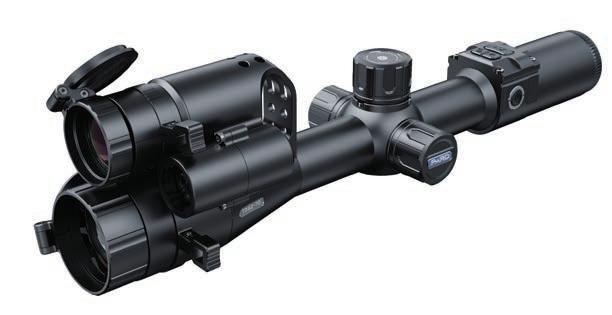
The integrated CMOS 1920*1080 visible light sensor combines a 70mm lens, 6.5-13X magnification, 2.6°x2.6° FOV, and visibility down to .001 lux. Available in 850nm wavelength, the VCSEL IR illuminator has three levels of intensity and directional focus out to 350 meters. The IPS LCD thermal imaging and night vision can be displayed on the 800x800 IPS LCD display independently or simultaneously with the picture-in-picture (PIP) function, providing a clear heat signature and night-vision depth perception. Display options include six individual reticle styles, four different reticle colors, and six different thermal image modes. SRP: $4,499. (pard.com)
The new 1-8x24mm SFP compact riflescope combines the best features of PA's popular PLx series with the ACSS NOVA reticle. This second focal plane reticle uses fiber-optic technology for a true red-dot bright aiming point to deliver the fastest possible target acquisition from close to medium range. At farther distances, the integrated mil holdovers and target auto-ranging make it easy to estimate distance and land shots with precision. New GLx series red-dot optics include the GLx MD-21, engineered for agility and precision from close quarters to medium range. This red dot features an advanced solar failsafe system that supplements the battery, ensuring the optic operates with maximum run time. The GLx 1x MicroPrism features new technology with a wider objective lens and updated internal design, superior glass, push-button controls, and improved reticle illumination. The SLx MD-21 is an advanced micro dot sight designed to deliver exceptional CQB performance. Weighing only 3.82 ounces, the SLx MD-21 features a new heavy-duty mount for rigidity and precision. The upgraded LED emitter offers complete night-vision compatibility as well as a true daylight bright reticle. (primaryarms.com)
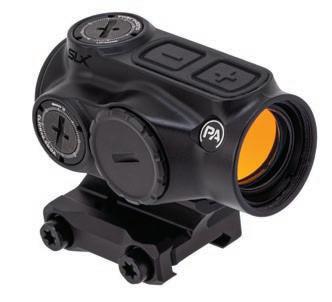





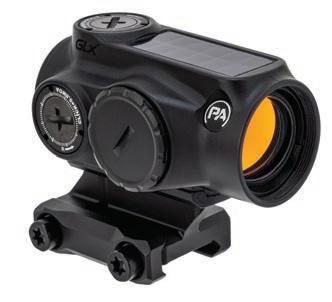
The new 3 Tactix EED (Enclosed Emitter Dot) red dot pistol sight (SRP: $350) features an enclosed emitter design that protects the internal components from dust, moisture, and impact for consistent and reliable performance even in challenging environments. Features include a 3 MOA dot reticle, large viewing screen, and adapter plate. The all-new 5 Primal 10x42mm ED binocular (SRP: $650) features premium ED (extra low dispersion) glass to provide a superior glassing experience. Features include an ergonomic aluminum-alloy body with rubberized waterproof coating. The new compact and lightweight 5 Primal 15-45x60mm spotting scope (SRP: $999) weighs 2.7 pounds and is 12.5 inches long, both of which will be appreciated by spot-and-stalk hunters. Features include ED glass, aluminum body, and large zoom and focus rings.
(ritonoptics.com)
The new S-TAC 1-6x24 AR1 LPVO riflescope (SRP: $499.99) is designed for AR platform rifles chambered in .223/5.56mm. The scope features Japanese optical glass lenses combined with Sightron’s MC-333 multi-coating technology for the best possible light transmission, contrast, and clarity. The S-TAC AR1 reticle is purpose-built for .223/5.56mm, and the illuminated halo helps with fast target acquisition at close range while the illuminated center dot ensures accurate mid-range target placement. The ExacTrack erector-tube system delivers consistent, reliable, and repeatable adjustments, even at the extreme edges of the scope's adjustments. (sightron.com)


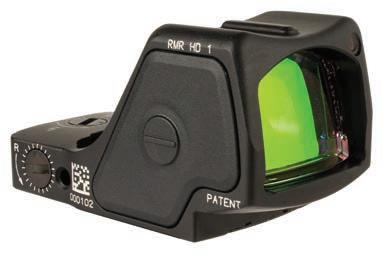
Two new red dot optics include the RMR HD (SRP: $849) and the RCR ($849). The RMR HD is a compact pistol optic built on the RMR Adjustable LED model, but features a large, clear lens. Users can toggle between a 55 MOA segmented circle reticle with a center dot or a crisp dot-only option, both of which include a new super-bright setting and an additional night-vision setting. Either a 1.0 MOA or 3.25 MOA center dot is available. The RCR (Ruggedized Closed Reflex) is a closed emitter optic. The 3.25 MOS reticle has 10 brightness settings that are adjusted manually; there are also three night-vision options and one super-bright option. Both the RMR HD and RCR have the same footprint as the RMR.
(trijicon.com)
New and improved second-generation R3D notch and post tritium sights are engineered to give gun owners a brighter and stronger set of self-defense sights. In addition, with the new EasyPress feature, the sights are now far easier to install. Designed to drive focus downrange, the new R3D 2.0 sights feature significant improvements from their Gen 1 counterpart. The two rear tritium dots are bigger and brighter than those in the original R3D. The new sights also have a PVC ring surrounding the rear sight lamps for a more defined edge to improve sight picture and further differentiate the front dot from the rear sight lamps. The rear sight is also blacked out and serrated to reduce glare. When paired with the high-contrast orange or green dual-illuminated photoluminescent Glow Dot front sight with a tritium vial, the R3D 2.0 provides more visible indexing for precision alignment.
The new sights also have a black nitride finish with double the corrosion resistance of the original black oxide surface treatment. The R3D 2.0 fits all Glock models as well as select Smith & Wesson models in the M&P/M&P 2.0 and Shield lines. SRP: $131.99-$142.99. (xssights.com)




















by Brad Fitzpatrick
hunting markets in 2024. Here’s a look at some of the most exciting new products this year.
Many people head to the woods or the shooting range to escape from technology, but there’s no doubt in the digital age that electronics are part of every facet of our lives—and that includes hunting and fishing. But unlike the emails and texts that mean more work and the social media notifications that distract you from that work, hunting and shooting technology can actually make your time on the range or in the field more worthwhile and enjoyable.
One product that certainly makes range time more enjoyable is Garmin’s new Xero C1 Pro chronograph, which is far and away the most user-friendly chrono ever designed. But that’s not the only exciting new product this year. High-tech handgun, rifle, and even shotgun electro-optics were on display at SHOT Show 2024; Leupold is now offering new rangefinding binoculars with ballistic data built-in, and Streamlight is packing more lumens into a lighter, more compact EDC light this year. Clay target shooting has gone wireless, Hornady is helping shooters call hits at long ranges, and Moultrie has developed a sleek new cell camera that cuts back on the unwanted photos of non-target game. Indeed, technology can make hunting and shooting more enjoyable. So, as you stock your shelves this year, take the time to check out these cool new tech products.
Garmin’s new Xero C1 Pro doppler chronograph is about the size of a deck of cards and it’s incredibly easy to use. There are four buttons (up, down, back/power, ok), making it intuitive and easy-to-operate, with the ability to read velocities from 100 to 5,000 feet per second. Although many other chronographs are finicky about noise levels and position relative to the muzzle, the Garmin is very forgiving, and it returns accurate velocity readouts within seconds. It functions with rimfires and suppressed firearms, yet it doesn’t register false readings when other shooters fire guns nearby. The unit also collects data for each shooting session, such as minimum and maximum velocity, average velocity, extreme velocity spread, and standard deviation. When you download the Garmin ShotView app and pair it to the chronograph you can adjust settings, review data, or delete shots or entire strings from your phone. The compact Xero C1 Pro is easy to carry, and there’s no need to walk downrange to set up a chronograph, which is a major concern with traditional chronographs. Battery life is exceptional: one four-hour charge with a USB-C cord (provided) lasts for 3,000 shots. The Garmin is so good that it has forever changed the chronograph market and initial response and demand for the Xero C1 Pro has been extremely positive. The Garmin is indeed a game-changer. (garmin.com)

Leupold makes outstanding optics, but their new BX-4 Range HD binos are a complete shooting system. They come with a built-in rangefinder that ranges deer to 1,100 yards and reflective objects to 2,600 yards with the touch of a button. The TBR/W (True Ballistic range with Wind) technology accounts for angle when providing range values, and it also provides wind holds as well. Shooters may choose from among 25 different ballistic groups to match their load; the BX-4 Range HD binos will provide not only distance to the target, but holdover values based on the ballistics of your firearm. The durable rubber exterior protects Range HD binos from damage, and the waterproof and fogproof lenses provide a clear, glare-free sight picture in all conditions. A sophisticated light-management system helps provide crisp, true colors even in dim morning and evening light. Twist-up replaceable eye cups come standard, and the two-button control layout makes it easy to range objects without moving your eyes from the glass. The two-button layout (with a reversible ranging button) also makes it easy to scroll through the settings. (leupold.com)
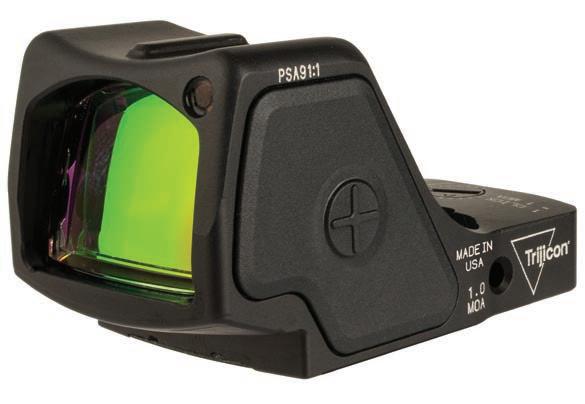
Long-range shooters know that identifying hits and misses on steel targets at extended distances can be a challenge, but Hornady is now offering an affordable, convenient solution. Their HIT Target Impact Indicator attaches to most target stands via an included elastic band, and a built-in accelerometer causes the LED red lights to flash. The red indicator lights, which flash the Morse code pattern for the word HIT, are visible for up to 1,000 yards with the naked eye depending upon weather conditions. A spotter using a magnified scope can identify flashes at even greater distances. This is hugely beneficial for long-range shooters because it offers a clear signal when you strike the target, eliminating confusion and reducing the need to send more shots downrange to verify. And since the indicator is not attached to the target face itself there’s less chance that an errant shot will damage the unit. Best of all, Hornady HIT indicators are USB-C rechargeable, so there’s no need to constantly swap out batteries.
(hornady.com)

Trijicon’s RMR has set the standard for duty-grade red-dot optics for years, but the design has been updated to meet the changing needs of law enforcement and military professionals with the addition of the new RMR HD. Fitting on the same footprint as standard RMR and SRO optics, the RMR HD offers a larger tempered glass lens with an advanced forward-facing light sensor that automatically detects ambient light conditions and matches the optic’s brightness accordingly. Owners can customize the auto brightness setting to make it brighter or dimmer, and there is a lockout feature that prevents accidentally adjusting light through contact with the optic. Shooters can also manually choose from among nine different brightness settings as well. The reticle includes 55 MOA circle and dot or single dot options, and the RMR HD is available with a 3.25 or 1 MOA center dot. The optic is powered by a single CR2032 top-loading battery with a runtime of three years of continuous use on setting 5 of 9. New, larger buttons make it easier to toggle through brightness settings quickly. Like the original RMR, the RMR HD comes with a precision-machined 7075 T-6 housing that is designed to reduce impact forces, and like other Trijicon optics it’s made in the U.S. (trijicon.com)

Burris is expanding their thermal optic line with the release of the BTS35 V2 scope. Its Burris Cyber Core thermal processor, 12uM 35mm objective lens, and 400x300 thermal sensor provide crisp, clear images day or night for accurate shot placement on hogs and coyotes. The thermal can be paired with the BurrisConnect mobile app to adjust settings, and video can be streamed to as many as five different devices in real time. With multiple reticle options, first or second focal plane digital reticles, contrast and thermal intensity control, and multiple color palette options, shooters can customize their optic to fit their needs. The user-friendly interface was inspired by video-game controls and is simple to operate even in complete darkness thanks to a simple rotary controller. Battery life is exceptionally good, and the Burris BTS35 V2 is hotswap compatible using widely available rechargeable 18650 batteries. With so many great features and such an intuitive interface, the Burris BTS35 V2 is one of the most appealing thermal optics available in 2024.
(burrisoptics.com)
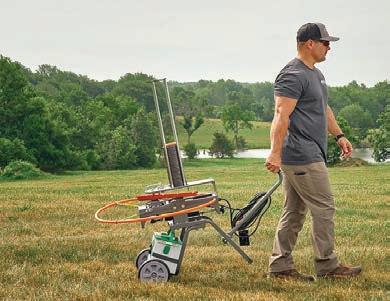

Shotgun sports are growing in popularity, and each year more high school and colleges add trap and skeet to their list of club and varsity sports—great news for rural communities. Whether you’re building a backyard clay target course for your student athlete or simply want to break clays with friends at the house or cabin, Champion’s new Wheelybird 3.0 Auto-Feed Trap is a perfect option. This lightweight, portable, automatic clay target thrower is powered by a 12-volt deep-cycle battery that rests on a battery tray at the base of the thrower. Wide, sturdy wheels make it easy to change thrower positions, and with a 60-count clay stack, 1.5-second cycle time, and angle adjustment (0 to 30 degrees) you can keep clays coming in a hurry and adjust target presentation. The Wheelybird 3.0 throws 108mm clay targets up to 70 yards with the touch of a button, and a remote 25-foot cord is included. You can also purchase a separate wireless remote that’s perfect for shooting coaches who want to deliver targets while standing at various locations to instruct student shooters. The Wheelybird 3.0 is easily portable, easy to set up and operate, and it helps improve shooting skills. (championtarget.com)
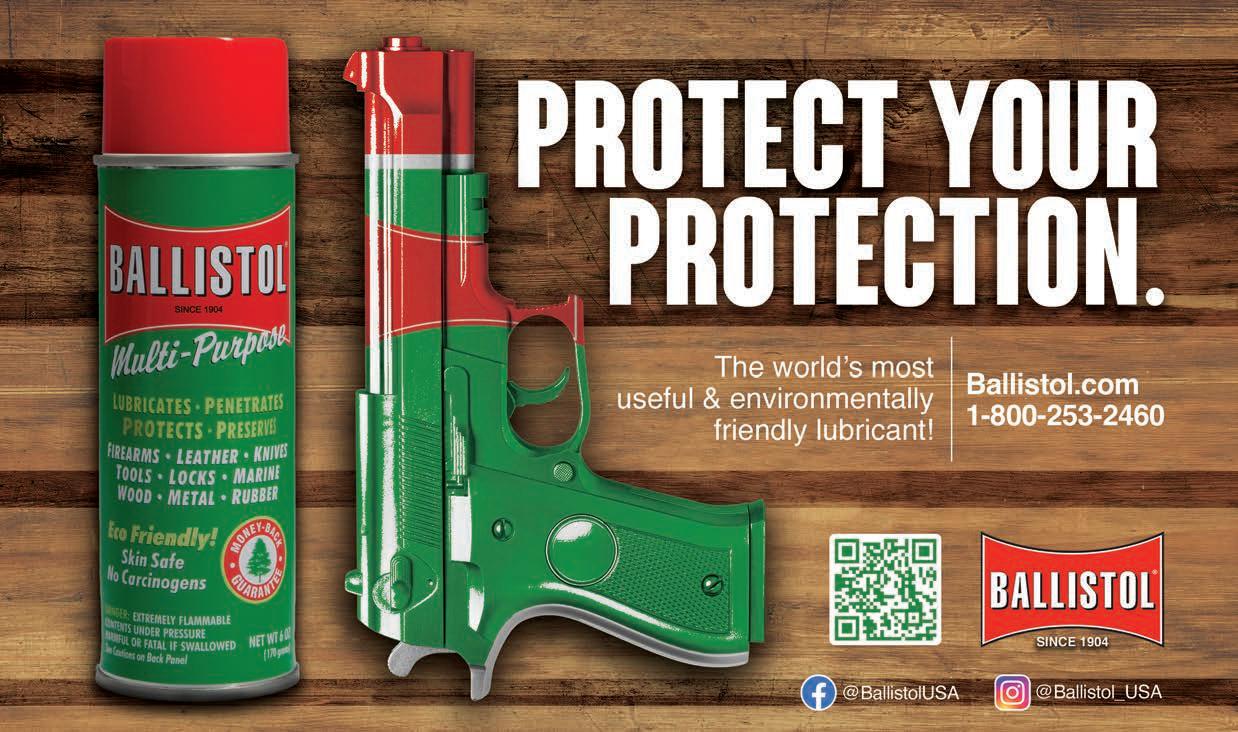
PRESERVING OUR VALUES PROTECTING OUR RIGHTS
SUPPORTING YOUR FIREARM BUSINESS



From the largest manufacturers to the smallest retailers, NSSF® fights to preserve our legacy and secure our future as a critical member of American industry. We fight with resources that promote legal gun ownership. We fight with initiatives that educate the public about responsible firearm ownership and safe participation in hunting and the shooting sports. And we fight on Capitol Hill and in state capitols nationwide—right alongside you—to ensure your ability to operate as a lawful and important business in your community is not infringed.
DON’T STAND ON THE SIDELINES. JOIN THE FIGHT BY JOINING NSSF TODAY.
NSSF.ORG/MEMBERSHIP
EDC flashlights are an essential part of a daily carry kit, and Streamlight is now offering a more compact version of their Wedge series, the Wedge XT. Measuring just 4.25 inches long and weighing 2.62 ounces, the Wedge XT is even smaller than the original Wedge flashlight. But don’t let the Wedge XT’s compact size fool you; this light produces 500 lumens and 1,900 candela with a 284-meter beam range at the touch of a button. If you’re saving battery life or simply don’t need to shed that much light on the scene, there’s a low setting that produces 50 candela and 200 lumens with a beam range of about 90 feet, the ideal light source when you’re fumbling with your door keys or you’ve dropped something in a dark parking lot. The Wedge XT is powered by a 950 mAh lithium polymer cell battery that is USB-C rechargeable. The battery can be fully charged in six hours and a red-and-green indicator light provides feedback on battery level. The aluminum-alloy body and polycarbonate lens allow this optic to stand up to the rigors of daily carry and the TEN-TAP programmable switch allows owners to customize high/ low or low/high programs. Run time on high is two hours while low runtime is 11 hours. A sturdy metal clip makes it easy to secure the Wedge XT in a pocket where it can be immediately accessed when needed. (streamlight.com)


I grew up shooting trap and skeet, and while I understand the value of a red-dot sight on a carbine or even a handgun I was skeptical about their value on a shotgun. However, the Aimpoint S-2 taught me I was wrong to doubt the value of a red-dot optic on a scattergun. At a range in Colorado where I tested Aimpoint’s new shotgun-specific reflex sight I broke 25 straight clays, which is considerably better than I did with the same shotgun sans red-dot sight. This small, sleek sight weighs just 2.4 ounces and comes with adapter plates that allow it to fit on the rib of most shotguns without modification. The 9 MOA dot is larger than most carbine and pistol sights, but it’s easy to see, and multiple brightness settings allow you to adjust the sight to ambient light conditions. The housing is small enough that it doesn’t distract the shooter, and I was surprised (and believe you will be, too) at how easy it is for shotgun shooters to transition to this optic—easier, in fact, than rifle or pistol shooters. Every shotgun coach in America teaches target focus, and the front bead simply serves as a reference point when making the shot. The same is true with the Aimpoint; it’s very natural to find the target with both eyes and use the oversized red dot as an improved front bead. The design makes sense for turkey and self-defense guns, but I think clay target shooters and upland and waterfowl hunters will be shocked by how intuitive and effective this sight can be.
(aimpoint.com)
I love running cellular cameras to keep track of the game on my property, but roughly 70 percent of my photos are of non-target species like squirrels and raccoons. Moultrie has developed an ingenious technology to reduce unwanted trail cam pictures with the Mobile Edge Pro camera. Smart Capture gives the operator control over which species you capture with videos or photos, and Smart Zones technology allows you to focus on key areas and ignore areas where you’re likely to get unwanted photos. Moultrie says that Smart Capture and Smart Zones help eliminate as many as 99 percent of false triggers—and that means no more sorting through hundreds of pics of swirling leaves, flocks of birds, possums, and stray cats to find the images of your target buck. Also, the Live Aim feature allows you to check the camera’s field of view using the Moultrie Mobile App on your phone so there’s no more guessing whether your photos are centered. NYXEL NIR infrared technology boosts lowlight performance, and you can capture 36 MP pictures and 1080 video with HD audio. Moultrie’s Auto Connect Technology allows for nationwide coverage and real-time access to photos of the bucks, bears, or bulls that are in your hunting area.
(moultriemobile.com)
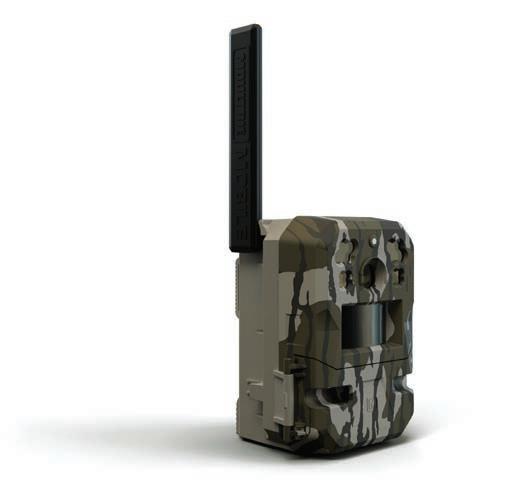
The FD-1LRF night-vision scope and rangefinder incorporates a 1920x1080 CMOS sensor and a 1,200-yard laser rangefinder into a single device that can be used as a monocular, a stand-alone scope, or a front-mounted clip-on device to an existing optic. This technology allows a user to turn their daytime optic into a night-vision platform instantly. Available in 850nm wavelength, the VCSEL IR illuminator has three levels of intensity. The FD1-LRF provides a 7.9°x5.9° FOV, 1X optical magnification, and sensitivity down to .001 lux. When used as a stand-alone scope, the FD1-LRF also incorporates a ballistics calculator, picture-in-picture (PIP) mode, and features six reticle styles, four reticle colors, and two independent image modes. Daytime or night vision images are displayed on the 1440x1080 OLED display. Additional features of the FD1LRF include a removable 128GB micro SD card that allows the user to capture 2592x1944 photo images and video, WiFi connectivity to a PC, tablet, iOS, or Android device through the use of the free PARDVision app, and USB Type-C and HDMI output connections. In addition, the unit is IP67 weatherproof and recoil proof to 6000J (think .308 caliber). SRP: $649. (pard.com)





The night-vision and thermal-optics markets are booming. Are they right for your business?
by Brian McCombie
My first night-vision hunt occurred near Yazoo City in the Mississippi Delta just over a decade ago. A good friend and his family raised crops on several thousand acres here, and the growing number of destructive feral hogs cost the operation thousands of dollars annually. My friend tried day hunting; it removed a few pigs, but never enough to slow the damage done to his corn and soybeans.
So, as many farmers and ranchers in the South and Texas were beginning to do, he invested thousands of dollars in night-vision gear and started thinning out local sounders after dark. That night, I wore a night-vision unit mounted on a helmet, abetted with a laser zeroed and attached to my Modern Sporting Rifle (MSR). With the night vision, the laser acted like a red pointer, stabbing deep into the dark.

We spotted a group of hogs rooting up a field and put a stalk on them. I opened fire at approximately 50 yards. Half a magazine later, I had three good-sized hogs on the ground. My heart was nearly thumping out of my chest. A few months later, I used a thermal riflescope on Texas hogs and coyotes. I was hooked! Hunting at night, for non-game species, became my favorite type of hunting.
As a writer, high-tech night hunting made sense, too. The night-vision and thermal technologies were awesome, they paired extremely well with the MSRs that were selling like hotcakes, and hog numbers were on a steep growth curve. I saw years of hunting and writing opportunities ahead.
However, I assumed widespread use of thermal and night-vision technologies would never happen. The units were simply too pricey to become really mainstream. I was right about the many years of hunting and writing opportunities. But, oh man, did I ever get the mainstream part wrong.
PARD USA offers night-vision and thermal riflescopes as well as handheld units. “Interest in the thermal and night-vision devices has exploded in recent years,” says Derick Cole, vice president of sales for PARD USA. “Historically, there have not been as many players in the domestic sales space to choose from as there are now. The number of brands vying for consumer dollars is more competitive than it has ever been. This increased competition has driven innovation and continues to drive prices down every year.”
“Over the past five years, we've seen consistent 15- to 20-percent growth annually, driven by
increased affordability and heightened demand,” says Steve Lemenov, director of marketing for Armasight. “The surge in interest, particularly in hunting feral hogs and predators like coyotes, underscores the expanding market and the desire of modern hunters to embrace innovative technology.”
Armasight produces numerous night-vision riflescopes and handheld monoculars as well as high-quality goggles. The company’s thermal units include riflescopes and mini handhelds.
Law-enforcement agencies, he adds, purchase significant numbers of these units, too, usually the handheld scanning variety.
At iRAY USA, Pliny Gale, director of marketing, notes that a number of other consumer groups have stepped up to his company’s thermal units. “There is strong growth in what I call the ‘aware citizens’ category,” Gale says. “They are individuals,
mostly found in rural or suburban areas, who see the value in thermal-observation tools for keeping an eye on the ranch or homestead.”
Search and rescue units, ski patrols, and game recovery/trackers are snapping up thermals, too.
These units often intrigue retailers. Then, they discover that the $2,500 to $3,000 retail price is the starting point for entry-level thermals, with $4,000 to $6,000 the nominal prices for upper-level units. Night-vision prices can be even higher, especially for the higher-end goggles that attach to helmets.
Yet, the widespread growth in these markets means more and more people are buying these pricey units. And these units generate profit margins far superior to the margins for firearms.
“While I can't disclose the exact margin levels of our dealers, I can tell you it is definitely more than the margins on most guns and a lot of ammo,” Gale says. “There’s also the obvious benefit of the efficiency of selling one high-end thermal product to make the same profit as selling a dozen guns or cheaper optics. I know which one I’d hope to focus on as a dealer.” iRAY USA thermals include the flagship RICO weapon sights as well as the newly launched M6T 25mm, a thermal vehicle-mounted scanner.
All sources SHOT Business contacted shared the same advice to the retailer thinking about offering night-vision and thermal units, in store or online: know the technology.
“Having a solid understanding of the technology’s fundamentals is essential to selling it,” says Armasight’s Lemenov. “While you may not need to be an expert in every intricate detail (that’s what we’re here for!), having a general knowledge of how the technology operates and the advantages it offers customers can significantly enhance your sales pitch.”

The TD62 combines PARD multi-spectral imaging technology with long-distance thermal detection, high-definition night vision, a ballistics calculator, and a laser rangefinder to create a single multi-function unit.

Gale notes that the iRAY USA dealers who have dived deepest into knowing the tech regularly sell out of his thermals. “It is not the price or technology that holds dealers back—it is the sales, marketing, and product knowledge,” Gale argues. “Geek out on the product, learn it, and you can sell it very effectively.”
So, how do you receive that education? Most night-vision and thermal manufacturers provide in-store sales and educational training, either using their own staffers or via sales rep agencies. PARD, for example, partnered with a 30-person national rep group to support dealer-level needs, including
in-store education of staff and consumers. In 2023, PARD also introduced a series of informational videos on topics such as the difference between NV and Thermal and optical versus digital zooms and many more related tech topics (pard.com/support/video-collection). “All of this is provided free of charge to any retailer that finds value in it to use on their website or in their shop,” says Cole.
Armasight recently launched its Night Vision University (armasight.com/night-vision-university) and Thermal University (armasight.com/thermaluniversity) websites. Both offer numerous articles that explain the respective technologies. They also feature examinations of individual units, their capabilities, and specifications.
In addition to its extensive online educational resources, PARD USA offers a full catalog of spec sheets and product comparison sheets as in-store sales aids. PARD USA also aids its dealers when introducing new products or upgrades. Last year, the company rolled out a line of upgraded thermal units.
“We supported this launch with a 100-percent product switch-out commitment at the retail level,” Cole says. “We also issued authorization for retail partners to submit a claim for price protection on

the new devices that were priced below our original offerings. Big margins for the dealer, no liabilities on product transition, and lower retail prices for the consumer.”

iRay’s HYH75W low-distortion eyepiece and a 1.03-inch large-format 2560×1920 AMOLED display provides comfortable viewing as a dedicated sight while still maintaining the pixel density and resolution required for use as a thermal clip-on.




redeemed through iRayUSA. Nothing beats selling from first-hand experience and personally owning and using the models you sell.”
Fusion is a newer entrant to the thermal market, offering scopes that feature the company’s intuitive three-button control system and an amazing clip-on unit, the Recon 55XR. “Preferably, we like to be onsite in our dealer partner’s store,” says Chris Wisecarver, president of Fusion Thermal. “We

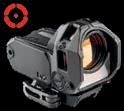
want to work behind the counter with the sales team. When they hear what we have to say to their customers about our products, they come away not only with better product understanding, but also the knowledge of how to sell the products.”
In addition, Fusion offers a full complement of literature ranging from catalogs to product specific brochures. “In a digital format, we also provide a counter sales tool that empowers even the freshest face behind the counter a step-by-step quick-reference guide on how to sell our thermals, from the user interface to the deepest tech information,” he adds. “We are expanding our point-of-sale tools this year to include counter mats and stylized and branded scope stands.”
“The beautiful thing about thermal is that it sells itself,” says Wisecarver. “You just need to turn it on and hand it to a customer. There is nothing else in your store that will make as dramatic a product demonstration as a thermal scope. It’s nearly impossible to find someone who doesn’t want one after they look through one.
“When I work with a dealer, I always have a thermal turned on. When a customer walks over to the gun counter, I say, ‘Want to see something


really cool?’ and hand him the scope. If he’s never looked through a thermal, it will blow him away.
“Even if that particular shopper does not buy, he will 100-percent be telling his friends about the cool thermal scope he saw in your store. The wave of interest and sales that follow using this simple technique is nothing short of amazing.”
One Fusion dealer, Texan Guns & Gear (texangunsandgear.com) in Stephenville, Texas, always has an MSR or two on display with thermal scopes mounted on the rifles. The display alone attracts attention. The shop will also give customers a bargain price on the rifles for a thermal-rifle combo sale. The relative few dollars lost by the rifle’s low price is more than made up on the thermal profit margins.
If you think that some customers are going to be intimidated and may assume they need to be a computer science Ph.D. to effectively use and understand night vision and thermal, you need to understand this assumption is simply not true. If a customer can navigate the functions and apps on their cell phone, he or she can learn and use today’s thermal and night-vision units, which are easier to operate than ever before.
True, it wasn’t always this way. Initially, zeroing a thermal scope was often an exercise in extreme acid reflux for this writer. The instructions were confusing when not outright contradictory, and the controls hard to manipulate. Every thermal scope I’ve used in the last couple years, though, possesses what is basically a one-shot zeroing system. Meanwhile, menu controls have gone to turrets that are more intuitive than the hard-to-feel button pads of the past.
Simplification has also come to the other functions like changing to different reticles for the scope models to taking video and photos to adjusting image quality. Having your customers make a few such adjustments at the counter will remove many tech-based fears.
These same companies are branding and marketing at a high level.
They are responsible for a noticeable surge of advertising on print and online platforms. They host numerous media events like demonstrations and hunts to generate content and work directly with social media influencers.
Social media has become a huge driver of night hunting, too. Night hunting groups are very popular on Facebook, for example, where they share hundreds of hunt videos with their members.
Yes, it’s kind of chaotic out there in this Wild West of Nighttime Technology. But units are selling like never before, with independent retailers cashing in with impressive profits. It all takes time and commitment, but then what doesn’t?

An Armasight Contractor 320 mounted on a Henry lever action helped the author take down this Texas hog.
Strictly Offensive Kit (SOK) is an online dealer offering night-vision and thermal units made by Armasight and others. Preston Walls launched SOK as an online business in 2021, and this entrepreneur is experiencing amazing growth.
“My business has really launched itself in a big way this year,” says Walls. “We’re on pace to at least double 2023 revenues.”
Walls spent many hours building up the business, which has coincided with an everexpanding interest in the technologies SOK offers.
“My opinion is that people are accustomed to the Amazon Prime mentality—got to have it now,” Walls says. “The way we support this is through superior customer service and a grace period for product returns free of charge, so long as it’s returned in the same condition received. It is costly to our business, but it’s the right thing to do.
“My number one goal is to talk to every single customer before they transact with us. SOK freely shares tribal knowledge and first-hand experience, free of charge, to ensure the customer has the best information available prior to spending their hard-earned dollars. This prevents product returns and ensures the solution fits their problem statement.”
Top items SOK currently sells include the Armasight Sidekick 640 Mini Thermal Monocular and the DJI Mavic 3 Thermal Drone.
Often “night vision” and “thermal” are used interchangeably to describe units that can help people “see” in low- to no-light conditions. Yet, in fact, they represent two very different technologies.
Thermal optics are not “optics” in the traditional sense. Essentially digital cameras, thermals identify electromagnetic radiation, what we non-scientists call “heat.” The unit’s front lens detects this heat; that information runs through a digital sensor or “core,” which projects an image to the rear or ocular lens.
Night-vision units, however, intensify the available light using image intensifier tubes or digital sensors to make images visible. That light can be from the stars or moon, streetlights, or other sources like infrared illumination.
Given these requirements, night vision doesn’t work in complete and utter darkness. It needs some sort of light or infrared help. Night vision also can’t be used during daylight hours, either.
Thermal can operate during the day. But certain environmental conditions, like high humidity and very dusty air, can degrade the images seen through a unit and reduce detection range.
By knowing the capabilities of the two technologies, as well as the pros and cons for specific uses, a retailer can effectively direct customers to the best units for the desired uses.


Small businesses are a big target for cybercriminals. Here’s how to prevent your network from being crippled by a malware attack.
by Todd Smith
Cyberattacks. Network security breaches. Ransomware attacks. Phishing catastrophes. If these terms aren’t top of mind for small business retailers and manufacturers, they should be. Recent statistics gathered by StrongDM ( strongdm.com ) show that cyberattacks against small businesses are on the rise.
• 61 percent of small businesses were the target of a cyberattack in 2021.
• 46 percent of all cyber breaches impacted businesses with fewer than 1,000 employees.
• 37 percent of companies hit by ransomware had fewer than 100 employees.
StationX (stationx.net) notes that small businesses also have the highest rating (one in 323) for targeted malicious emails, and employees of small businesses experience 350 percent more social engineering attacks than those at larger enterprises.
Why are small businesses such a big target? The answer lies in a lack of preparedness. Of the small businesses that collect credit card information, nearly one third do so without any cybersecurity protections at all, according to StrongDM.
While the trend is slowly changing, most small business owners still believe they are too small to become the target of a malware attack. As a result, they fail to take even the most basic precautions to protect their networks and data files.
Not bolstering network security makes small businesses far more attractive to hackers who would much rather attack a small, defenseless enterprise than take on a large company that has invested in staff and security measures to protect their networks. Sadly, too many small business owners up their network security only after they’ve suffered a cyberattack. Some are pushed right out of business.
Fortunately, there are a number of steps small business owners can take right now to beef up their cyber defenses—and they don’t cost a fortune. Here is just a sampling of the simple things you can do to avoid becoming a cyberattack statistic.
Securing your network starts with introspection. Take the time to do a self-evaluation of the system you have in place by asking yourself the following questions.
• Who are you doing business with?
• How are you transacting business with them?
• Is the network you’re using to conduct business sufficiently firewalled?
• Are the crown jewels of your database— bank ing files, tax returns, and customer information—truly secure?
• Who has access to your network and why?
While the trend is slowly changing, most small business owners still believe they are too small to become the target of a malware attack.
• Do you have sufficient guidelines in place for employees regarding internet use and email security?
• Are you adequately insured against a cyberattack?
• What would happen if hackers attacked your network right now?
If you answered “no” or “don’t know” to any of these questions, perhaps it’s time to invest in a more thorough evaluation by having a reputable cybersecurity firm look over your operation, run some attack scenarios, and see what your challenges and risks are. They will quickly sort out your weak points, make recommendations to bolster your cybersecurity against future attacks, and may provide suggestions on how to conduct business in a more secure way that ensures data privacy for you and your customers.
One of the least expensive ways to guard against cyberattacks is to educate yourself and your
employees about cybersecurity and what your expectations are for protecting your data. This should start the day you onboard new employees and be followed by regular training sessions so the entire staff stays up to date on the latest security threats.
Establishing simple rules regarding the use of unique passwords (and an insistence on changing them every three months) is a good place to start. Following a best practice used by banks, implementing multi-factor authentication that requires additional information beyond a password to gain entry to your network will also help prevent breaches.
You also need to set up strong guidelines for protecting customer information and sensitive data. Establishing a policy that includes internet guidelines will go a long way toward protecting your network.
Your local bank can be a big help in establishing these best practices. Financial institutions want you to stay in business, so they are happy to share all kinds of tips that can help strengthen

Manufacturers that utilize large data pools need to install stringent employee-use protocols for their computer networks in order to prevent ransomware attacks.
The battle lines are drawn for us and the stakes are high.
Each election hundreds of millions of dollars are spent to elect candidates who vehemently oppose our freedoms. They mock our values and beliefs, while working to destroy our industry and eliminate our rights.
That’s why Protect Liberty PAC was created to protect our liberty, defend America’s cherished freedoms, and save the firearm industry.
Just as our Founding Fathers joined together to lead a fight for liberty and freedom in the face of tyranny, so can we.
Please join with us in our fight today and let’s safeguard the firearm industry and our liberties before they disappear forever.


It is critical that your employees be schooled about phishing and instructed to not open any emails that seem even the slightest bit suspicious. You should also keep your systems up to date by ensuring that all software updates are made in a timely fashion.
your businesses’ cybersecurity profile without spending a fortune.
Take a few minutes to search your bank’s name online followed by “how to secure small businesses from cyberattacks.” You’ll be amazed at what this simple search will reveal.
Chase, for example, has a number of cybersecurity articles online including: “How to help protect your business from one of today’s biggest cyberthreats” and “7 tips for a more secure business online.” Security magazine is another good source, as is the Federal Communication Commission (FCC), which has a number of smart cybersecurity tips for small business owners.
As defined by the FCC, “a firewall is a set of related programs that prevent outsiders from accessing data on a private network.” If the
operating system you’re working on has a builtin firewall, make sure it’s always activated. Employees working from home also need to make sure that their computers are firewalled. And they should not be using their personal computers for office work. If you have remote employees, provide them with a dedicated business computer that is separate from their personal devices and accessed only by them. Business email addresses should also be established separately.
StationX reports that “on average, an employee of a small business with less than 100 employees will experience 350% more phishing and other social engineering attacks than an employee of larger enterprises.” These attacks can look like emails from a reputable company, bank, vendor, or friend. Once an employee clicks on a
phishing link, however, the hackers can access your network, steal sensitive data like customer names and credit card information, or, worse yet, introduce ransomware that locks up your network until you pay a ransom. This is why many companies are now beginning to invest in technology that “sanitizes” all inbound emails (and any attached files) to ensure malware can’t enter their systems (see sidebar).
It is critical that your employees be schooled about phishing and instructed to not open any emails that seem even the slightest bit suspicious. Equally important is that you establish a company culture in which employees are encouraged to report any phishing incidents without fear of retribution. Better to find out right away that something may have happened than to have an employee not report a potential breach because they were afraid of losing their job.
Small businesses are especially vulnerable to cyberattacks. Employee education is a key component to securing vital data.
Keep your systems up to date by ensuring that all software updates have been made so you’re using the latest versions. Keeping sensitive business data on a separate computer will also help to keep your data secure, and it should be backed up regularly to ensure that all customer data is secured.
Only allowing employees access to the data systems they need to do their jobs will help keep your data files separated and secure. And never allow anyone to install software without your permission as uploads can contain hidden malware that can compromise your system.
Security magazine says that the best way to protect your network is by using “a strong password that is at least 16 characters, featuring a randomized mix of letters, numbers, and special characters.” Anyone connecting to the network from outside the office should also use a Virtual Private Network (VPN), which allows remote workers to connect securely.
Most business owners already insure their enterprises against theft. Smart ones take the next step and ask their agents about adding cybersecurity insurance as part of their coverage. Yes, it’s an added business expense, but it is far less costly than what a cyberattack and resultant data breach will cost.
The FCC has some smart things to consider when purchasing cyber insurance. Above all, they recommend that your policy should include coverage for:
• Data breaches (like incidents involving theft of personal information).
• Cyberattacks on your data held by vendors and other third parties.
• Cyberattacks (like breaches of your network).
• Cyberattacks that occur anywhere in the world (not only in the United States).
• Terrorist acts.
Taking precautions against cyberattacks may take a little investment in time, hardware, and software in the short term, but it can save your business from a catastrophic attack that could seriously cripple your ability to do business in the future. Check out some of the accompanying resources and start getting cybersecure today by educating yourself and your employees to ensure a cybersafe tomorrow.
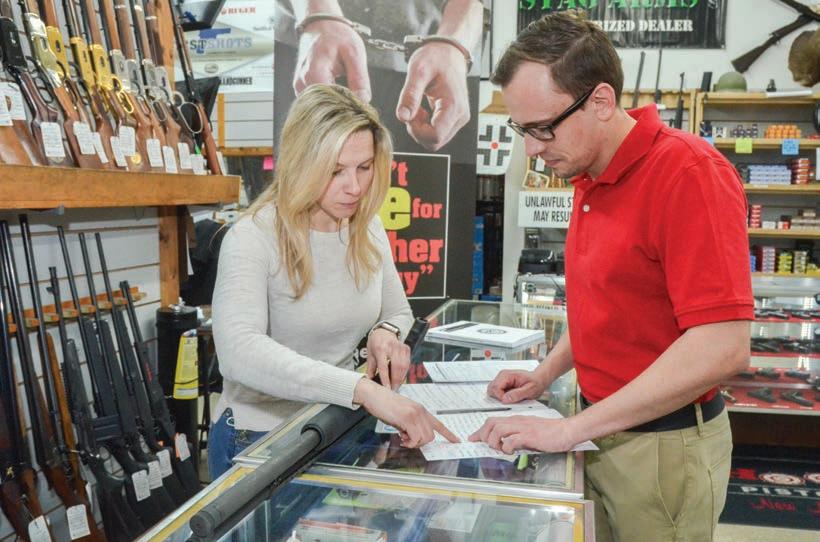
Depending on the size of your business, you may wish to consider the following. Small businesses with less than five employees can follow many of the suggestions set out above: train your employees, protect your computers and network against cyberattacks, use a firewall, backup all of your data, control access to your computers, and create separate user accounts for each employee. In addition, secure your Wi-Fi networks, limit employee access to sensitive data files, and insist that passwords be strong, unique, and changed every three months.
Medium-size businesses with 10 or more employees will want to consider all of the above, and they may wish to explore additional cybersecurity measures such as sanitizing emails and any files being transferred into a company from outside sources. OPSWAT (opswat.com)offers an extensive line of Peripheral Media Protection solutions to protect critical business network environments from file-borne threats on any media type. Their MetaDefender Kiosk Mini will be of particular interest to manufacturers running computerized, product-manufacturing equipment that requires a secure way to ingest software updates.
Businesses working with a number of outside vendors also need to understand whether any of the vendors in their supply chain have been breached as malware lurking within their system could easily infect your network. To identify and continually monitor those in your supply chain, Panorays (panorays.com) offers a unique solution that provides a real-time security rating for all of your third parties so you can continuously adapt your security measures accordingly.
Big businesses, manufacturers, and government contractors that manage huge data pools and satisfy stringent government compliance standards will need to consider all the above. They may also benefit from Quanta’s Decision Intelligence Platform (quanta.com), which takes data management to a higher level by using Artificial Intelligence to automate and augment decision-making by providing a complete, 360-degree view of customers and their counterparties.
The Federal Communications Commission lists the following resources from The Office of Communications Business Opportunities as additional resources for small-business owners:
The GCA Cybersecurity Toolkit for Small Business ( gcatoolkit.org ); What Small Business Owners Need to Know About Cybersecurity and 3 Biggest Cybersecurity Threats Facing Small Businesses Right Now ( entrepreneur.com ); and Small Business Resource Center ( microsoft.com ).
Other sources for cybersecurity information include Small Business Cybersecurity Center ( list.gov ); Cybersecurity for Small Business ( ftc.gov ); the National Cyber Security Alliance Small and Medium Sized Business Resources ( staysafeonline.org ), and Protecting Your Business From Cybercrime ( score.org ).
by Mark E. Battersby


Today’s high interest rates have put that all-so-necessary funding out of reach for many in the shooting sports industry. This situation is compounded by the reluctance of many traditional lenders to provide that all-important working capital required by every business.
Actions of the Federal Reserve have contributed to an increase in inflation and raised interest rates with no indication of substantial relief in sight. Combine those higher interest rates with leasing and purchase prices essentially doubling in the last few years and funding the shooting sports business today is extremely difficult.
With the well-documented reluctance of banks to provide the funds needed by those in the shooting sports industry, it may seem strange to suggest that every search for affordable funding should begin with the operation’s bank. Although numerous factors will impact the type of lender eventually chosen, the best option is usually to start with the bank currently used for the operation’s banking.
"When traditional sources, even with guarantees, fail to provide affordable needed financing it might be time to explore a relatively new option: online funding."
Even without a personal relationship with the banker, an existing bank often has a broader perspective of the operation’s debt, spending, and cash flow. While perhaps only a number in the bank’s system, the operation is already in the system. That puts the shooting sports retailer or manufacturer one step ahead, even with a reluctant bank.
Obviously, if a relationship with the operation’s current bank isn’t sufficient to overcome the bank’s reluctance to provide the needed funds—or render advice—a new bank might be necessary. Since banks are often the source for the most economical financing, a community

bank might be the answer. Establishing relationships with community banks is often easy, with them considering the operation as a whole alongside the operation’s cash flow, credit, and collateral factors.
In general, all banks are interested in businesses that have collateral and strong credit. Often, while not interested in providing long-term funding, banking services such as cash management, payroll services, merchant services, and lines of credit may be available.
Every business should already have a line of credit to help tide them over the short term. A line of credit provides access to funds up to a pre-set limit, and the equipment retailer or manufacturer pays interest only on the funds withdrawn. Fees for having the funds readily available are usually competitive. However, as finding capital becomes more difficult, it’s more important than ever to determine why the shooting sports retailer or manufacturer needs capital, how fast it is needed, and most importantly, what it can afford to pay for that capital.
Although banks, especially community banks, typically have low interest rates and offer competitive terms, financing continues to be hard to obtain. Thus, an incentive such as a guarantee by the Small Business Administration (SBA) might help obtain that needed funding.
The SBA offers lenders a federal loan guarantee. This makes it less risky for banks to lend and often means more favorable interest rates and terms for the borrower. Repayment periods for SBA loans are based on what the funds will be used for. They range from seven years for working capital to 10 years for equipment purchases and 25 years for real estate purchases. There are a number of SBA loan guarantee programs available. SBA 7(a) loans, the most popular program, provide funds for many purposes and are available in amounts up to $5 million. SBA 504 loans offer long-term, fixed-rate financing to purchase or repair real estate, equipment, machinery, or other assets. SBA Micro Loans are







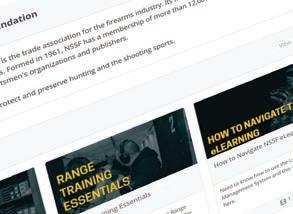





NSSF’s SHOT University™ Online is a onestop e-learning platform for firearms retailers and ranges. On-demand and free for NSSF® members, this new library of interactive online courses provides a deep-dive on critical topics ranging from compliance and regulatory issues to operational guidance and business improvement for both business owners and employees.




FOR RETAILERS:
• Planning for an ATF Inspection
• Standardizing Operating Procedures
• Inventory Management
• Notice of Revocation – Are You Prepared?
FOR RANGES:
• Road Map for Range Safety and Health
• Addressing Lead at Ranges
• Marketing Your Training Programs
• Membership Strategies – Lessons from the Fitness Industry
and more!
The SBA offers lenders a federal loan guarantee, making it less risky for banks to lend. The result is often more favorable interest rates.

the smallest loan program offered and provide $50,000 or less to help businesses expand.
When traditional sources, even with guarantees, fail to provide affordable needed financing it might be time to explore a relatively new option: online funding.
With the reluctance of traditional banks to lend, online lenders are enjoying a surge of popularity. Best of all, specialty financing, such as gun and ammunition inventory loans, is available. Online banking eliminates the cost of brick-andmortar branches, thereby generating cost savings to be passed on to borrowers.
Fintech, or financial technology, consists of two areas: interacting with a bank minus the human element and independent lenders working outside the traditional banks. Applying for an online business loans can be accomplished entirely online.
An effective strategy for minimizing the cost of the funds needed by the business involves selling the business. An employee stock ownership plan (ESOP) is a tax-effective way to transfer ownership of a small incorporated shooting sports equipment business to its employees while raising the funds needed for the operation’s growth. With an ESOP, the business issues new shares of stock and sells them to the ESOP. The ESOP then borrows funds to buy the stock. The retailer or manufacturer can use the
proceeds from the stock sale for its own benefit—growth or expansion.
The business repays the loan by making taxdeductible contributions to the ESOP. The interest and principal on ESOP loans are tax deductible, which can reduce the number of pre-tax dollars needed to repay the principal by as much as 34 percent, depending on the operation’s tax bracket.
Unfortunately, the tax shield does not help with S corporations, as they don’t pay corporate income taxes. Capital gains deferral, however, can make ESOPs attractive to these passthrough business entities.
Obviously, it is wise for every business owner to have at least some personal funds at risk to show lenders or potential investors that the owner is committed to the success of the business. Unfortunately, our tax laws make selffunding a touchy and complex situation.
The most basic, affordable funding strategy, called bootstrapping, means using personal or family funds to finance the business. Offsetting the convenience of bootstrapping is the necessity for the owner or shareholders to give up equity in the shooting sports business.
What’s more, whenever a loan is made between related entities, or when a shareholder makes a loan to his or her incorporated business, our tax laws require a fair-market rate of interest be included. If not, the IRS will step in and make adjustments to the below-market
(interest) rate transaction in order to properly reflect “imputed” interest.
Dealing with an economical, but unfamiliar lender isn’t always trouble free. A loan agreement might, for instance, contain a provision requiring the loan to be repaid if the buyer misses several payments or fails to maintain certain debt service coverage. Every borrower should have a clear picture of when the forbearance will end and what the lender intends to do at the end of that period.
What’s more, every borrower should generally match the term of a loan to the life of the item to be financed. If the financing is for equipment, the loan shouldn’t be longer than the expected life of that equipment. On a similar note, a fixed-interest rate stays the same throughout the term of the loan while business loan rates can fluctuate, making them more expensive.
In the search for capital, the easiest options may be the most expensive.
* Credit card debt. Business credit cards often offer more flexible repayment terms, but typically have higher interest rates than traditional financing. Designed to appeal to businesses whose cash flow might be irregular, the higher cost of business card debt results because the debt is usually unsecured, making it riskier for lenders.

* E-mail solicitations. Answering those “We Lend Money to Businesses” ads means leaving the banking sector with its various protections and borrowing from a private lender. These options should be avoided.
After funds have been obtained at a favorable cost, it doesn’t mean that the interest is automatically tax deductible. There is something called the “tracing rule” where interest is traced to its use to determine whether or not it is deductible.
Suppose, for example, a business borrows money, but only a portion is used to purchase needed equipment. The balance of the borrowed funds goes to a key employee or even the owner to purchase a personal vehicle. Obviously, the interest on the borrowed funds used for equipment, supplies, or other business expenses are deductible. The interest on the portion of those borrowed funds distributed as a loan or bonus is not tax deductible.
Every business in the shooting sports or outdoor trade seeking to borrow money faces challenges. For example, where is funding available? What interest rate? What is the total cost including fees? Is the funding good for an extended period of time or can payment be demanded early? Guidance from a professional adviser may be necessary.
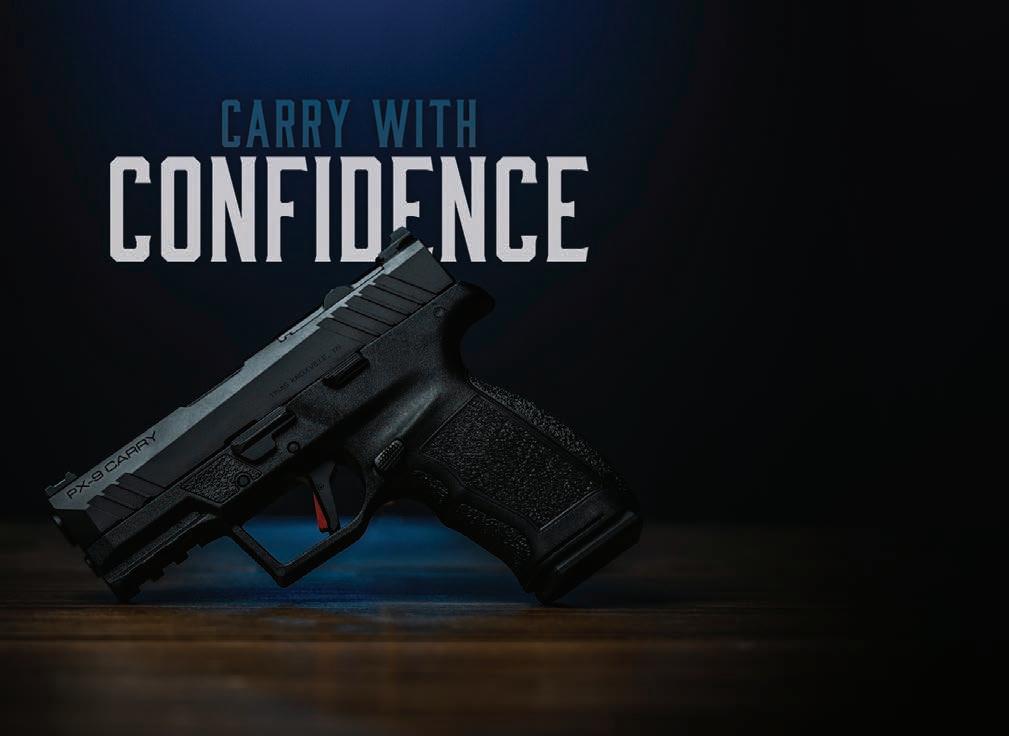



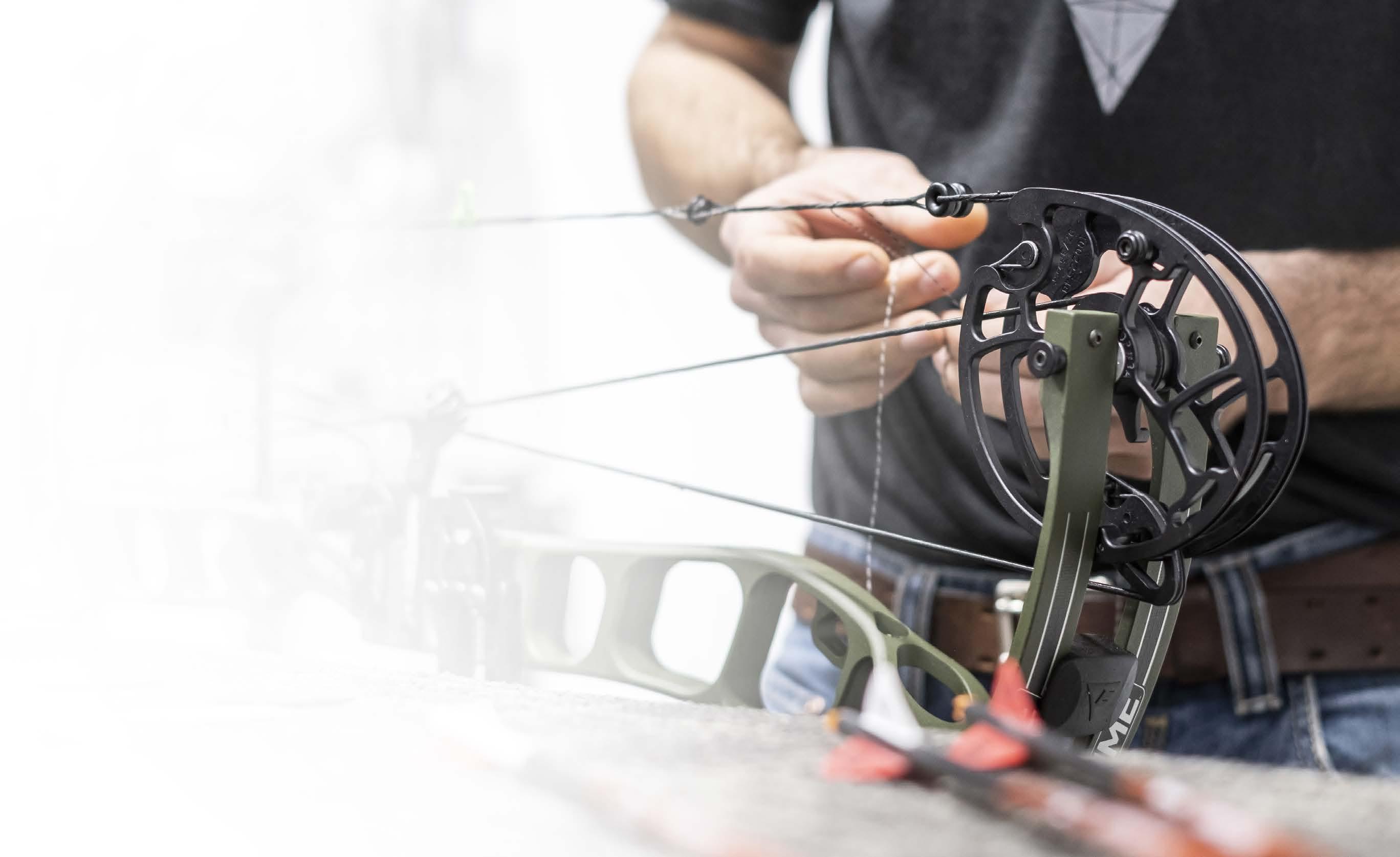









































Located in the heart of Phoenix’s urban metropolis, this retailer specializes in a mix of hunting and home defense firearms and outdoor accessories. The store keeps an inventory of nearly 1,000 guns and has a seasonal staff of four.
Although dove season is open, this retailer is concerned with customers adjusting to the hotter weather. “It has been a slow summer—and really a slow year. In our area, we’re finding that shooters are just not spending time in the desert like they have in the past. The over-100-degree days are catching up with us. To adjust, I’ve moved some of our inventory to Gun Broker; that’s been a good solution to offset slower summer turns,” said owner Kurt Stancl. He does note that even though dove season has been slow, he has seen shotgun turns on Stoeger M3000s and Benelli Montefeltros. In addition, cases of No. 8 shotgun ammo are moving quickly.
bank Just north of the Griffith Park Zoo, this metro Los Angeles firearms store keeps an average of 100 guns in stock in a small Burbank storefront. Selling handguns, rifles, and shotguns, they cater to a wide variety of clientele, including Hollywood actors, stunt workers, and producers.
Despite the hot weather, sales are brisk. Handguns are turning daily with a mix Glock 19s, Springfield Hellcat Pros, and Sig P365s. Although this retailer doesn’t enjoy dealing with the constantly changing California regulations, he says it’s a learned skill.
“We wanted to help gun owners have a better experience with their gun purchases. We have a lot of clerical work that must be done, but through careful planning and good communication, our customers feel well served,” said owner Jonathan Solomon. Sales at the MSR counter include Anderson Arms and Wilson Combat AR-10 rifles. Popular bolt guns include the Savage Axis and Remington 700.
Security & Firearms, Waipahu Located 14 miles west of Honolulu, this store offers rifles, pistols, shotguns, reloading supplies, accessories, and training. The company also features a nine-lane indoor shooting range. It has 70 guns in stock and an extra 50 available for rentals. The store attracts a variety of tourists, island hunters, and shooters.
Handguns are bread-and-butter items for this retailer and range. Sig P365s and P365Xs top the sales chart. Other fast movers include S&W M&P 9 Shield EZs and Glock 43Xs.
“We have great foot traffic and feel our consistent sales are driven by the range and our well-stocked inventory. It’s not easy waiting a month for a barge to deliver much of our orders, especially ammo. It can be even more challenging when our orders sit on the dock in Long Beach due to labor shortages or paperwork challenges,” said manager Jim Pickers.
Supply, Grand Island Holding close to 300 guns, this central Nebraska smalltown retailer has an active clientele of home defenders, distance shooters, and trap enthusiasts. The store supports an average of three employees; it also has an online presence.
Coming off a strong first quarter, this store has been in the summer doldrums. However, owner Rice Forgy feels sales are now picking up steam. Handguns are moving, with good turns on Sig P365s, Glock 43Xs, and Shield EZs. “Day in and day out our handgun sales represent 70 percent of our business. It’s remained consistent for years,” he said.
Shotguns are seeing a mix of sales between early season waterfowlers and high school trap and skeet leagues. Strong sellers include Winchester SX4s, SKBs, and Brownings. “Late every summer we get several new young shooters looking for their first shotgun. It’s super gratifying,” said Forgy.
ILSimpson Ltd. Firearms for Collectors, Galesburg Located in western Illinois, this unique firearms retailer specializes in antique firearms that attract a discerning customer. Located across from the Amtrak station, this storefront and turn-of-the-century warehouse holds nearly 18,000 used and 500 new firearms. With more than 20 employees, staffers include gunsmiths, sales, and inventory.
While the store keeps a fluid number of new handguns, sales are trending with Sig P320s and P365s and Smith wheel guns. This specialty retailer is known for their expertise and large inventory of Lugers and 1911s.
“We seek out a large number of collectors and estate experts to secure guns across the world, many of which have historical significance,” said sales manager Floyd Gray.
On the rifle and shotgun side, customers have bought old hard-fo-find Brownings, Winchesters, and even L.C. Smiths.
St. Croix Outdoors, St. Croix Falls With over 1,000 guns in stock, this large northern Wisconsin outdoor shop keeps a wide variety of new and used hunting, clay, and home defense guns in stock. The log cabin storefront is 30 miles northeast of the Twin Cities just off Route 8. Shotguns are hot with a mix of early season waterfowl and upland guns. However, it’s the local high school trap leagues that make the register ring. “We love these kids and their parents coming in to buy their first guns just to shoot in these high school leagues. They spend a notable amount of money that’s often not tied to other shooting sports. We take great care of them and offer a lot of encouragement,” said counter salesman Brian Pilot.
Stoeger and Franchi are the leading brands at the shotgun counter, with high numbers of M3000s and Condor Supremes going out the door. Winchester SXPs and Browning Maxis are also steadily gaining attention.
Red Dot Training Range,
New Castle This seven-lane range is located halfway between Pittsburgh and Cleveland. Keeping an average staff of four, with approximately 150 firearms in stock for sales and rentals, the inventory is a mix of home defense and hunting guns.
Glock is the clear leader at this counter. The most popular pistol is the 43X, followed by the 19. Springfield’s Micro Hellcat also sells well.
This range owner reports 9mms are taking over. “Our range has become totally driven by 9mm. I have cases and cases of .45 and .40 just collecting dust. Even our lawenforcement customers are just shooting up the department’s inventory of old ammo and then making the change over,” said owner Justin Mateer. A growth service at this range is emergency medical training, which began in spring 2024. They offer a program called Nine Minute Medicine. The class fills a niche between military self-aid/buddy-care training and civilian EMS training. Tailored for
individuals with limited or no medical experience, it provides students with critical, needto-know information. “We see this as an important growth segment and are selling trauma kits to our customers,” Mateer said.
Fenelton Firearms and The Range, Fenelton Established in 2014 and located in western Pennsylvania northeast of Pittsburgh, this family-owned business stocks a variety of firearms and accessories for hunting, self-defense, and competitive shooting. In 2018, they opened a 10-lane indoor shooting range offering private and group instruction.
While many retailers are experiencing slower traffic, this store is having a strong year. Handgun turns have been brisk; the Shield M&P Plus, Glock 43X, and Sig P365 lead the way. “We’ve offered a number of deeply discounted sales for our price-sensitive clients. We were lucky to build our range pre-Covid. It absolutely has had an impact on our traffic,” said buyer Brent McLafferty.
This small-town New England gun shop resting 35 miles south of the Canadian border keeps a wide mix of traditional hunting guns, home defense, and military antiquities. A local fixture, the shop attracts storytellers, antique collectors, bird hunters, and farmers.
The handgun counter is an unusual mix of Colt 1911s, Sig P365s, and Glock 43Xs. Used Smith wheel guns also attract attention. “Although I wouldn’t call this year a struggle, it’s been one of the slowest we’ve seen. Sales are starting to pick up as it cools. I really think there’s a lack of new products. In response, my customers are looking for older guns,” said owner Josh Dagnese.
While MSRs are selling at one a month, this store is turning every M1 Garand it can find in just about any condition. At the shotgun counter, 20- and 28-gauge overand-unders are picking up, and a few used Brownings and Berettas are finding homes for upcoming grouse season.
GA Southeast Armory, Augusta Just two miles up the road from the Augusta National Golf Club, this large independent specializes in both fine firearms and basic deer rifles. A wide customer base helps fill this store with a large section of estate guns and special military collectibles.
Sig P365s, Hellcats, and Shield M&P9 EZs, most of which are 9mm, rule here. A few larger-caliber Glocks (.40 and .45) are also moving. “We continue to grow in compact and micro-compact pistols. This year they are strongly outpacing anything larger,” said counter salesman Nick Burck.
Shotguns are picking up quickly for dove season. Benelli Super Black Eagle IIIs are in the lead, followed closely by Franchi Affinitys. Flats of bird shot are moving quickly out the door. This retailer commented that it’s been almost three years since they have seen any deliveries of .410 ammo.
MSRs are turning at about two a week with a mix of Daniel Defense, Radicals, and Springfields. Savage Axis bolt guns are
starting to move, and there is renewed interest in Remington 700s. The most popular caliber remains .308.
Located in the southeastern end of the state, this small independent gun and pawn stocks about 400 new and used firearms. It offers a private shooting range and firearm safety classes.
While the summer has been slow, the handgun counter is picking up. Glock 43Xs, Sig P365s, and a wide mix of used revolvers are on the move. MSRs are slow, and this retailer reports that customers are very price sensitive. Typically, new and used MSRs in the $400-$600 range are heading out the door.
“We’re known in the community for our conservative position. We’ve built our store with hard work with no financial help from anyone. Customer service and knowledge is how we sell our products, and we stay busy,” said owner Doc Wacholz.
Located in west Jacksonville off Highway 228, this large independent stocks more than 2,000 guns. It also offers a full line of soft goods, archery, and fishing and hunting gear. This retailer boasts the best inventory it’s had in years, and they are feeling the hot weather. “Man, it’s been a slow summer. I’m sure it will pick back up, but we’re down to the lowest turns in ten years. In our archery department, it’s a 42-year historic slowdown. It just seems strange. It’s an election year, and our local employment picture is very good. To compete, we simply must get more creative,” said owner Abie Farhat.
The handgun counter is ticking forward with sales on Ruger LCP Maxs, Hellcats, and Shield M&P9 EZs. Farhat said discounted sales will be key to building traffic in the coming season. Dominated by lower price brands in the $500-$600 category, MSRs are turning at about one to two a week. DelTons and Radicals are their best sellers.
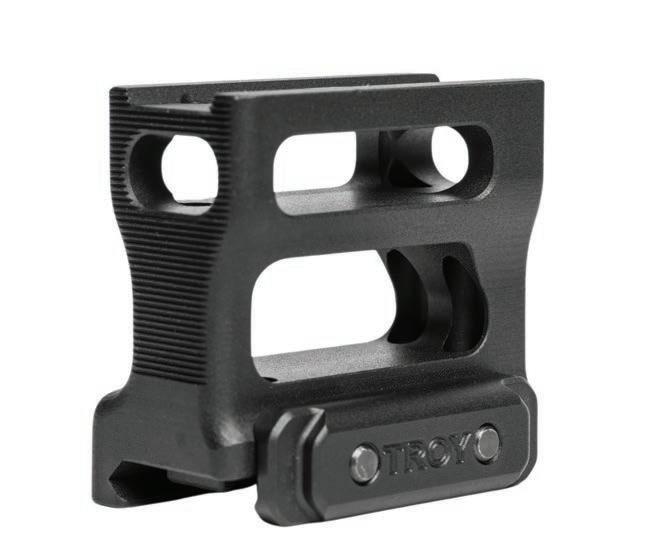
Modern shooting stances place the shooter facing the target with the buttstock lodged firmly in the shoulder pocket. Unfortunately, such a position often means the shooter must lower the head to the optic in order to acquire the target. Troy’s Statis is a 2.26-inch optic mount that solves this problem by allowing you to keep your head upright for greater situational awareness, reaction time, and ergonomics while engaging targets. This height also sets your optic at the perfect level for use with helmet-mounted night-optical devices, gas masks, or face shields.
A full-length clamp and two precision-machined cross bolts lock the mount to your rail. Troy also has inset the locking bolts so there are no additional protrusions to create snag hazards. Set to co-witness standardheight BUIS, the Stasis window eliminates the need to deploy folded backup irons, roll your rifle to offset sights, or fumble with bulky QD systems if your optic goes down. The Stasis mount is compatible with optics sharing the Aimpoint Micro footprint. (worldoftroy.com)
ProTek Watch has expanded its Official USMC Watch Collection with the addition of Seiko 24-jewel automatic movements in its Carbon Composite Case dive watches. This is the same workhorse movement found in many of Seiko’s great dive watches. The watch also has ProTek’s unsurpassed tritium illumination that glows for 25 years.
Designed in Switzerland, ProTek is an American watch brand, conceived and manufactured with quality components to ensure years of wear with no issues. The new USMC dive watch series features Carbon Composite Cases with tight unidirectional ratcheting bezels, embossed stainless-steel-screw case backs bearing the USMC logo, antireflective sapphire crystals, screw crowns, and genuine rubber straps. The watches are rated to 300 meters water resistance. SRP: $695. (protekwatch.com)


The Bodyguard 380 caught the attention of many when it first launched at SHOT Show 2010. Since then, the series has offered various models with lasers, external safeties, and even engraved slide finishes. With this next generation of micro handguns, Smith & Wesson set out to deliver a pistol with unparalleled performance in a small and lightweight platform.
When compared to the original model, the Bodyguard 2.0 boasts a new profile, has a higher capacity, and includes modern design enhancements that make this the ultimate concealed-carry choice. Chambered in .380 Auto, the pistol ships with a flush-fit 10-round magazine and an extended 12-round magazine, giving the user substantially more capacity. All models will be available with or without a thumb safety.
The Bodyguard 2.0 has an overall height of 4 inches, a width of just under 1 inch, and weighs in at 9.8 ounces unloaded, which provides the user with a more comfortable fit and improved control. It also includes a striker-fired design and new flat-face trigger for better consistency and more accurate shots. Out of the box, the pistol ships with a black u-notch rear sight and a bright tritium-insert front sight, both of which allow the user to rapidly acquire and stay on target. SRP: $449.
(smith-wesson.com)
Traveling with firearms and expensive accessories such as riflescopes and rangefinders can be a nail-biting experience, especially once you hand a rifle case and gear bag over to an airline. But the Scout Travel Luggage Tag can help ease the tension. Attach one to your gun case, and another to your cargo bag, and then enjoy the peace of mind they bring as you embark on your journey.
The USB-C rechargeable tag has a pair of especially worthwhile features for the traveling sportsman. The Luggage Finder uses Apple’s Find My technology so you can quickly locate your luggage anytime, anywhere, with the Apple Find My app. The Luggage Alarm helps deter theft with a motion-sensitive 85 dB alarm to immediately draw attention and trigger a notification to your iPhone (when in Bluetooth range). The lightweight tag attaches securely to bags using an anti-tamper bolt and braided stainless-steel cable. SRP: $59.95. (us.knog.com)

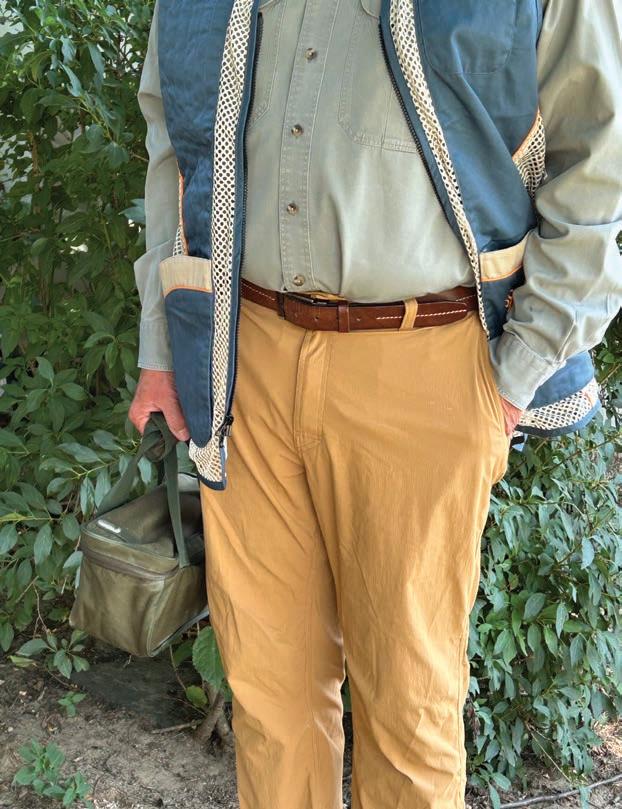
Clay target shooters who practice or participate in a match during hot weather know all too well just how uncomfortable it can get if you wear jeans or heavy khaki. Stio has come up with a better idea—the Coburn Pant. With a slightly roomier, gusseted, articulated fit and a greater range of sizes and inseams, the Coburn offers the look and feel of a casual pant, but with the technical capabilities needed for a long day on the range.
Stio’s secret ingredient is reTetonic Twill, a two-way stretch recycled nylon twill fabric with a durable water-repellent finish. The nylon/spandex blend provides abrasion resistance, durability, and slight stretch for enhanced comfort. A double-layered kickpatch at the back leg opening delivers added durability. You’ll also find a roomier fit through the legs. And, this mid-rise pant weighs only 15 ounces. SRP: $109. (stio.com)
The Signature HD 15x56 now joins the original 8x42, 10x42, and 12x50 Signature HD models. Designed with everything a hunter needs for glassing distant game and precision shooters need spotting impacts on targets, the newest Signature HD binocular delivers an expansive field of view and maximum low-light visibility.
Featuring Bak-4 glass with Phase Correct, dielectric coating found on the prisms, the Signature HD 15x56 delivers optimal resolution, color fidelity, and light transmission. Precision-ground lenses include Hi-Lume Index-matched multi-coating to further boost clarity, light transmission, and to eliminate glare. And to ensure the view is always clear, the binoculars are nitrogen-filled for reliable waterproof and fog-proof performance.
Since the Signature HD 15x56 is intended to give hunters the broad visibility and far-reaching magnification demanded in open country, it follows that the Signature HD binoculars are built to take everything the most austere western environments can dish out. To that end, the Signature HD 15x56 features an ultra-rugged, shockproof body that can suck up the hard knocks along with a tough rubber armor that offers additional protection and impact absorption. Every Signature HD bino includes a tripod adapter mount on the bridge for stable observation.
Integrated no-slip texturing makes the Signature HD 15x56 suitable for everything from hot, early-season antelope hunts to frigid, late-season mule deer and elk hunts. Add in a comfortable neoprene neck strap and stout, metal eyecups for eye-relief adjustment, and you have a binocular system that is a reliable partner whether you are hunting on foot, on horseback, or cruising in the ranch truck. SRP: $960.
(burrisoptics.com)


























PRS Tac-Grip slings solve the age-old problem of keeping a rifle securely on your shoulder. Two models, both American made, are offered— Traditional and Hands-Free.
The Traditional sling starts with a comfortable shoulder pad designed with laser-cut laminated Cordura blended with closed-cell foam and nonslip Tac-Grip material. This system offers strong gripping power in wet/ dry conditions and works great with technical clothing materials. Hands-Free rifle slings offer choices for extra control during rigorous use. Choose between over-the-head neck-strap carry or engage full-bodystrap carry. Either way, when game is sighted press the quick release and rotate the firearm into the shouldered position for shooting. The fastadjust slider can be easily engaged for a tight and secure shot.
To engage as a neck strap, quickly pull the military-grade elastic strap over the head for secure walking or quick two-handed tasks. To engage the body strap, pull the strap over the shoulder for cross-body carry. Doing so leaves the arms free for climbing, ATV riding, decoy carry, or game retrieval. All slings include stud swivels.
(tac-shield.com)
In 2019 Hawke launched the entry-level Vantage series of red-dot sights. The manufacturer followed that up with two new and improved Endurance red-dot sights in 2020. Both optics have been popular with value-minded AR owners. Now, the New Frontier 1x22 red-dot boasts a series of improvements designed to enhance performance while still maintaining an affordable price point.
The biggest selling point to the sight is Hawke’s all-new Auto Illumination Mode (AIM), which allows for battery life expectancy of up to 50,000 hours. A.I.M. capabilities work by automatically turning the illuminated reticle on when the sight senses movement and turning it off when inactivity is detected for longer than two minutes. The sight will power on again as soon as movement is detected. A 10-stage digital brightness control includes two nightvision-compatible settings.
The 1x22 Frontier red-dot uses Hawke’s proprietary System H7 optics for enhanced clarity and features a 2 MOA dot and 1⁄2 MOA adjustments. Highgrade aluminum construction, recessed brightness controls, guarded turrets, and IPX7 waterproofness are additional features. The sight comes boxed with a low-profile Weaver/Picatinny mount, a lower one-third co-witness mount with quick-release, and a Micro T-2 footprint for limitless mounting options. Also supplied is a honeycomb sunshade and protective flip-up covers. SRP: $329. (hawkeoptics.com)

SHOT Daily serves as the exclusive printed show title for up-to-the-minute accounts of the latest news, product introductions, seminars and other announcements. 8,000 copies are distributed daily to exhibitors and attendees, totaling 32,000 copies over four days. Daily live section covering booth presentations, new product introductions and more.
Do you have news-worthy content you would like our editorial team to consider? Send our team an email to shotbusiness@colepublishing.com







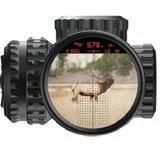




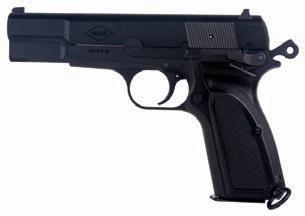





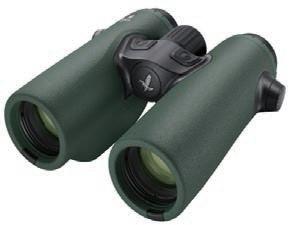







Shooting sports retailers are not part of the typical business world. We’re much bigger than that.
When Jayne and I started the business in 1981, like many of you we wanted to make a lot of money and live a good life. God, on the other hand, had a different plan. We became part of a “cause-based” business. That clarity of vision shifted us and the business into a wholly different way of thinking and operating. Our mission—should we choose to accept it—was to grow the shooting sports in ways that had not previously happened. This was a noble task, and it had to be faced in that same spirit. This spirit is not what you would normally find in the “for profit” business world. The guests we were attracting right out of the chute were not part of the traditional shooting family fold. At first it was a bit confusing, but we quickly found people that had an exciting curiosity and eagerness to see and experience a new world. That led us to understand that everything we did—including how we looked, how we acted, how we showed respect, and how we answered questions—mattered. Everything in the store mattered as well, including overall cleanliness, presentation, signage, and even the look and feel of the restrooms. Our entire operation needed to be inviting, simple to navigate, and inclusive. And then—no small matter—we had to train the staff and get them to buy in to what we were doing. If we didn’t raise the bar here, we would be just another “old school” store.
This new group of shoppers (what we referred to as “our guests”), which eventually totaled in the millions, were, and are, hungry to learn and be a part of our world. They expected, and deeply appreciated, respectful answers to questions, history, and uses of the many components that make up our industry. Many times, folks who haven’t grown up in the shooting sports will have questions that may seem odd to longtime industry folks. Oftentimes, many of the old school shops would have “duh” answers that only served to demoralize an inquisitive mind.
Here are some examples of those “odd” questions.
1) How is it that a .38 Special will work in a .357 revolver? Isn’t .38 is bigger than .357?
2) How can a .22 Long Rifle round fit into a handgun?
3) Can you explain the different names for 9mm: Luger, Kurz, Makarov?
4) Can I really shoot a .308 in a 7.62x51 gun?
5) Why does a .223 round look just like a 5.56 round?
That’s a starter list of questions. There were many more. As staffers, we would laugh at the crazy nomenclature that’s a rich part of our industry, but we never laughed at our guests for posing those questions. It was a sign of an inquiring mind, and we always felt lucky (and honored) to be asked.
Along the way we discovered that this very process was viewed by our new guests as akin to finding out something secret and special. They felt more a part of the now growing family of shooters. We saw first-hand the fellowship that bloomed between them and other like-minded shooters.
This fellowship is a truly joyous experience to observe. Our guests, having been welcomed into our world with open arms, reciprocated in many ways. They celebrated life milestones, such as birthdays, engagements, marriages, swearing-in ceremonies, anniversaries, and remembrances, with us. But two of the most meaningful were watching a parent helping a young adult get their first firearm-safety lesson or helping a new guest buy their first gun. In other words, our business and their sport have become part of their normal everyday lives.
As the years passed the stories those folks shared with their family and friends grew as well, and those stories became force multipliers helping to drive our business forward. Our success had another community benefit. As word got out about how we ran our business, other dealers began to adopt some of our methods, all to the benefit of new shooters.
We are not in a normal line of work. The first visit for many of the folks who come and see us can be compared to a young child’s fear of going to a doctor. But a caring attitude and kind words help alleviate that fear, turning trepidation into confidence.
As our business grew I was frequently approached at the grocery store, restaurant, or mall by folks (many of whom had never entered our store) who wanted to tap my expertise on all aspects of the shooting sports. What an opportunity to spread the word about who we really are! No matter how busy I was, I took the time to answer all sorts of questions—in the process correcting wrong assumptions about our industry.
The Simple Truth is that you, along with your staff, should nurture an attitude that will grow the shooting sports in a very healthy way. It’s a noble cause that you can do, and I’ll bet you can do it even better than we did. Thank you for allowing me to share this with you, and I would love to hear your stories and ideas, too.

New shooters have lots of questions. Answering them with respect will pay big dividends for you and your store.

Author bio: Miles Hall was founder and president of a multi-million-dollar firearms retail store and gun range in Oklahoma for 36 years. He is now a senior advisor helping FFLs around the country run more efficient, profitable businesses. (HallnHall.com)


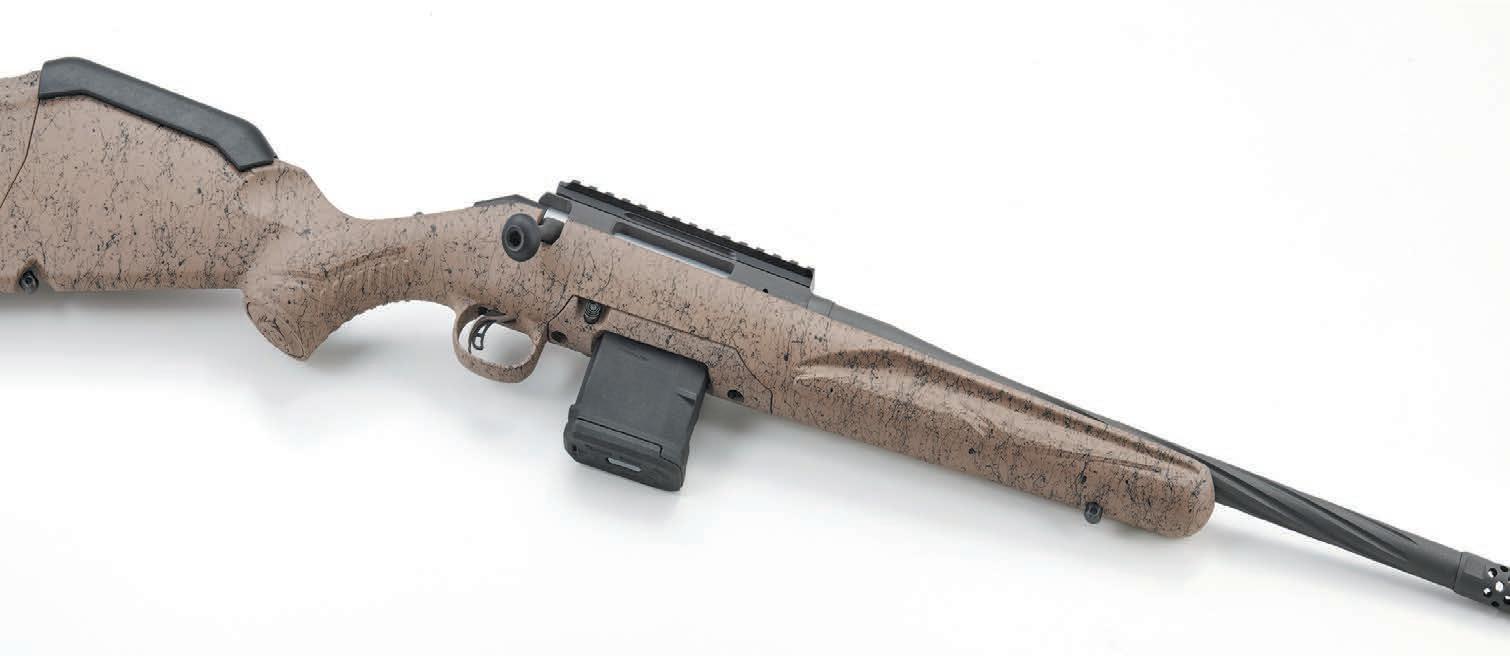

The Ruger American ® Rifle Generation II; an update to the American-made rifle that has been the benchmark for accuracy, durability, and performance in bolt-action rifles for over a decade. Designed with customer feedback in mind, the Ruger American Rifle Generation II is available in a variety of calibers and is sure to become the first choice for hunters and firearms enthusiasts.

LEARN MORE
The acquisition, ownership, possession and use of firearms are heavily regulated. Some models may not be legally available in your state or locale. Whatever your purpose for lawfully acquiring a firearm – know the law, get trained and shoot safely.